|
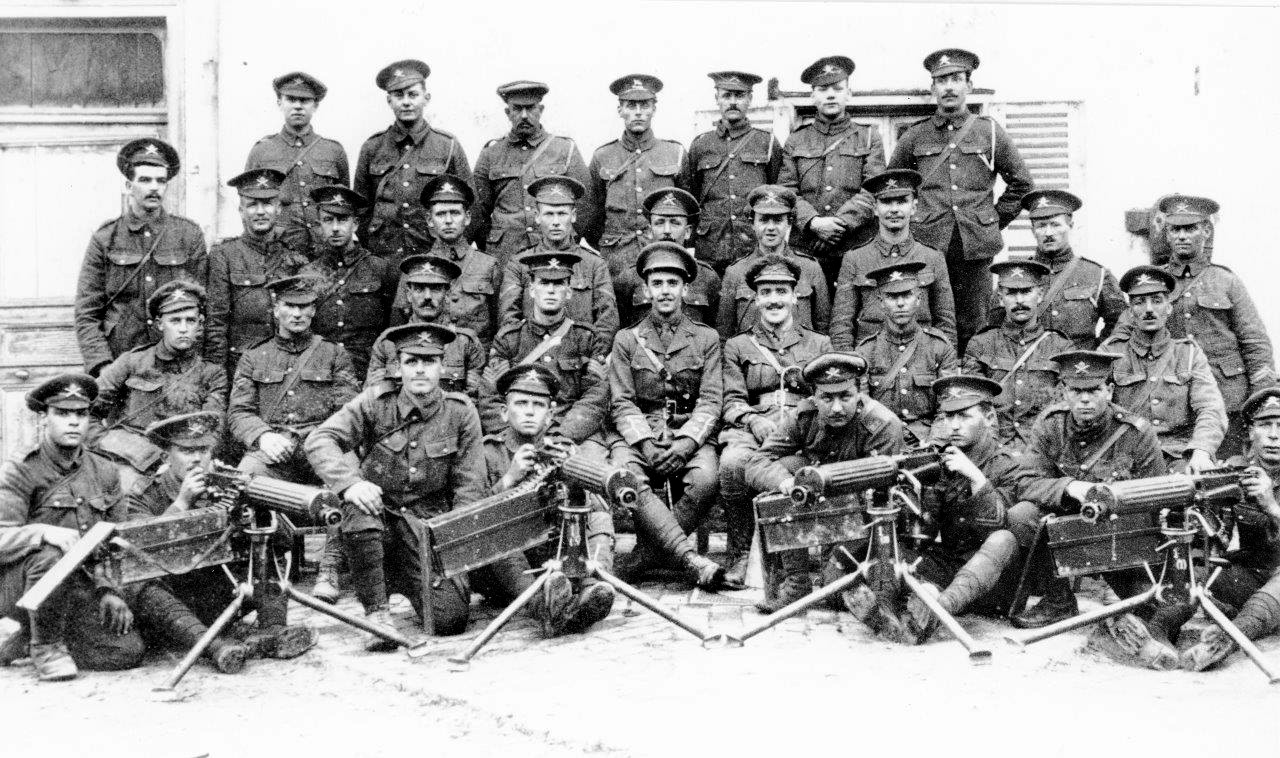
Troop of the Machine Gun Corps.
Guy Ronald Bass, great uncle of Tring local historian Mike Bass, is
in the 2nd row from front, 4th from right.
Guy joined up as private 1915, was promoted to 2nd Lt in 1917 and
awarded the Military Cross in 1918.
|
Temp/2nd Lt. Guy Ronald Bass, M.G. Corps.
For
conspicuous gallantry and devotion to duty while in command on one
Vickers gun. He kept his gun in action in face of direct enemy
machine gun fire, and when compelled to withdraw it 100 yards went
back for ammunition to his original position. While there he saw a
wounded man lying 200 yards off, and went out and brought him in. He
displayed fine courage throughout.
Supplement to the London Gazette, 26th July
1918. |
(Captain Guy Ronald Bass, lately Senior
Superintendent, Hong Kong Police Force, was awarded
the Colonial Police Medal (CPM) in the 1947 King’s
Birthday Honours.)
|
ANDERSON TO CROSS
JOHN HENRY ANDERSON
Private, 44th Bn., Canadian Infantry (Manitoba) Regiment,
service no. 460667.
Son of Mary Jane Anderson of Tring.
Died of wounds on the 3rd April 1917 at the 22nd Casualty Clearing
Station.
Buried in Bruay Communal Cemetery Extension (grave ref. D.16), Pas
de Calais, France.
The 44th Battalion (Manitoba), Canadian Expeditionary Force, was an
infantry battalion of the Canadian Expeditionary Force. The
Battalion was authorized on the 7th November 1914 and embarked for
Great Britain on the 23rd October 1915. It disembarked in
France on the 12th August 1916, where it fought in France and
Flanders as part of the 10th Infantry Brigade in the 4th Canadian
Division until the end of the war.
This from the 44th Canadian Infantry War Diary for 2nd April,
1917, the day on which Private Anderson was fatally wounded:
“BOUVIGNY
1/4/17: On the evening of 1st April the
Battalion moved to billets at BOUVIGNY, being quartered in the
Chateau and outbuildings there. 48 reinforcements reported
from Canadian Base depot, HAVRE; also 49 reinforcements previously
under training at 4th Divisional School were absorbed.
2/4/17: Inspection and refitting of Companies carried out during
day. Parties hitherto detached from the Battalion being
employed as working and carrying parties with the Engineers and
Artillery. At this date the strength of the Battalion was 43
officers and 1032 other ranks, these being the highest figures since
arrival of the Battalion in France. The actual strength
present with the unit was 34 officers and 1020 other ranks. In
view of forthcoming operation, platoons and companies were
reorganized, and the various detachments formed.
During the day enemy shelled BOUVIGNY and vicinity, one man being
wounded in billets.”
From the
Tring Parish Magazine:
“John Henry Anderson of the 44th Canadian Battalion was severely
wounded on April 2nd, and taken to the 22nd Casualty Clearing
Station [Note] where he died the next day, after having a leg amputated.
The Chaplain, writing to his mother, says: ‘He was too weak to talk, or be talked to much, but as I was
kneeling by his bed, I could just hear him joining in the Lord’s
Prayer.’
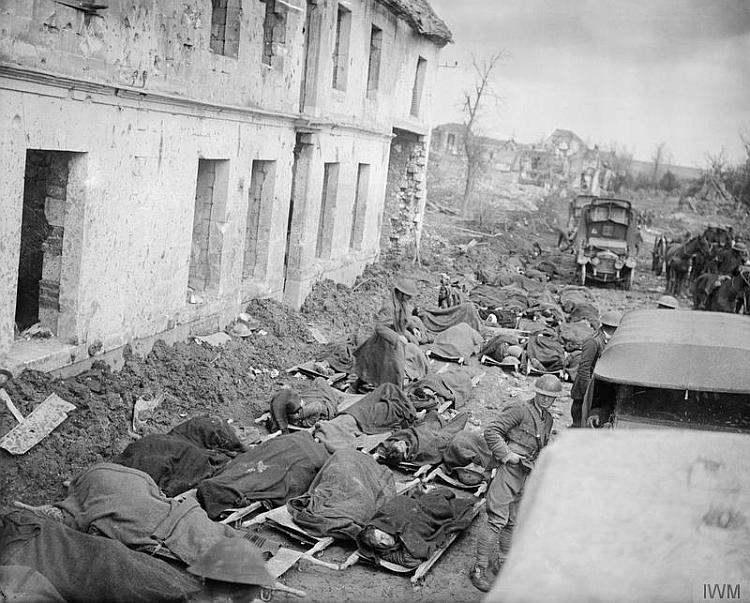
Stretcher cases awaiting transport to a
Casualty Clearing Station lie on the ground outside
a dressing station at Blangy, during the Battle of Arras in
April 1917.
Five years ago Jack was one of a large
party who left Tring for Canada, and about two years ago he joined
the army there. He returned to this country some time ago and
went to France with his gallant countrymen and has been in the thick
of the fighting ever since.”
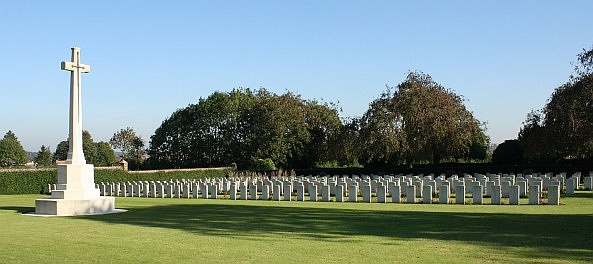
Bruay Communal Extension Cemetery, Pas
de Calais.
The Bruay Communal Cemetery Extension was begun by French troops in
October 1914, on land belonging to the Compagnie des Mines de Bruay.
When the French Tenth Army handed over this part of the line to
Commonwealth forces in March 1916, the 22nd Casualty Clearing
Station, which was established at Bruay, continued to bury in it.
Nearly half the burials in the extension are from the Canadian Corps
who occupied this sector from early in 1917. There are now 412
Commonwealth burials of the First World War in the extension.
The Commonwealth plots, which were designed by Sir Edwin Lutyens,
also contain some French and German war graves.
――――♦――――
GORDON WILLIAM ASQUITH
2nd Lieut., 3rd King’s Own Yorkshire Light Infantry.
Son of Mr. Bentley Asquith of Park Road, Tring.
Killed in action 2nd December 1917, aged 19.
No known grave. Commemorated on the Tyne Cot Memorial,
Belgium, panels
108-111.
2nd Lieut. Asquith was killed during an assault on the Passchendale
Ridge on the 1st/2nd December 1917. After proceeding only
fifty yards, his Company, led by Captain
Lambert, experienced devastating losses. The following extract is from the 2nd KOYLI War Diary:
[Note]
“‘C’ Company left the tape in perfect
order. After going some 50 yards they came under heavy
machine-gun fire and all the officers and senior NCOs became
casualties (Captain Lambert, 2nd Lieutenants T.S. Goode and C.S.
Allen wounded, 2nd Lieutenant G.W. Asquith missing).
The fire appeared to come from directly from our front and flanks.
In spite of this they pushed on. Sergeant Hayward was then in
command of the company and reports that he went a distance of 500
yards. At one point he crossed the PASSCHENDAELE – WESTROOSEBEKE
road about V.30.b.0.08 and found some derelict field guns and
shelters, the occupants of which were killed. He then found
himself in front of a line of trees, which were held by the enemy in
force. Sergeant Hayward, the only remaining company leader,
took stock of the situation and decided to remain under cover where
he was with the seven men who had miraculously accompanied him thus
far.”
From the Bucks Herald 15th December 1917:
“MISSING - We regret
to hear that Mr. Bentley Asquith, of Park-road, has received
information that his son, 2nd Lieut. Gordon W. Asquith, of the
K.O.L.Y Infantry, is reported missing after an engagement with enemy
on December 2. The official notification states that Lieut. Asquith
is not reported wounded, and it may therefore be surmised that he is
a prisoner in enemy hands. Much sympathy is felt with Mr. Asquith
and his family in their period of anxiety. Lieut. Asquith received
his commission about six months ago on coming up from Sandhurst, and
was only sent to France some six weeks back, when he attained his
19th birthday.”
Gordon Asquith joins many others who have no known grave and whose
sacrifice is commemorated on the Tyne Cot Memorial.
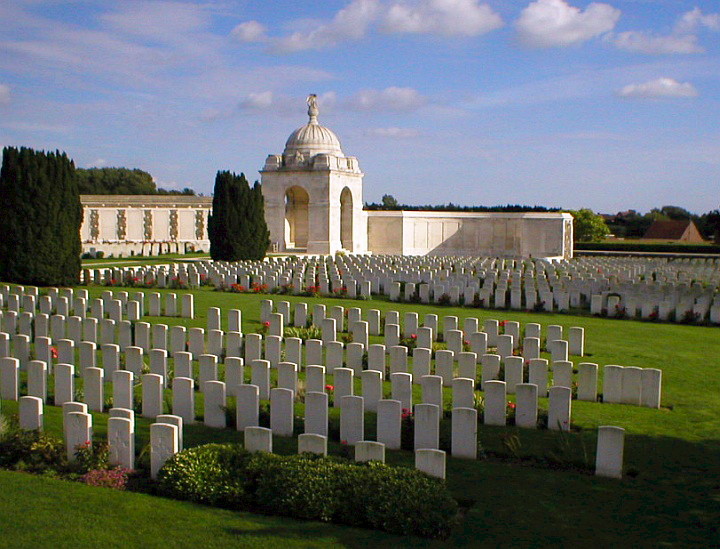
In the background are the walls forming
the Tyne Cot Memorial,
with one of the rotundas.
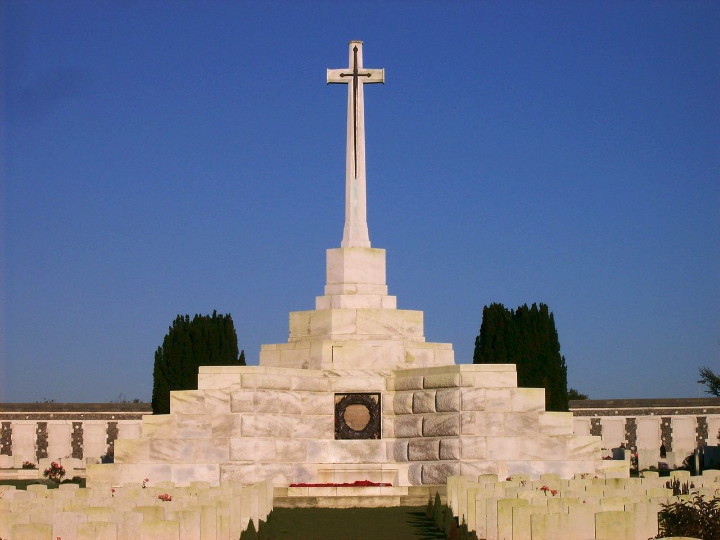
The cross at Tyne Cot Cemetery was
incorporated into a pillbox.
――――♦――――
JAMES EDWARD AYRES
Private, Royal Army Service Corps, service no. T/440813.
Died of pneumonia on the 23rd October 1918 at Woolwich.
Buried in Greenwich Cemetery, Screen Wall 1 C. B. 1145.
From the Bucks Herald, 2nd November 1918.
“James Edward Ayres, of Akeman-street, who
is well known in the district, having for many years acted as porter
at local auction sales, as a waiter at many public functions, and
also as a news-agent for Sunday papers, joined the army less than a
month ago. On Wednesday in last week his wife was sent for to
Woolwich, where Ayres was in hospital with influenza, which was
followed by pneumonia, and soon after her arrival he passed away.
The deepest sympathy is extended to the wife and daughter in their
bereavement.”
It is likely that Private Ayres fell victim to the influenza
pandemic [Note] that swept the
world between January 1918 and December 1920, bacterial pneumonia
being a common secondary infection. It is estimated to
have caused between 50 and 100 million deaths (3% to 5% of the
world’s population), making it one of the greatest natural disasters
in human history.
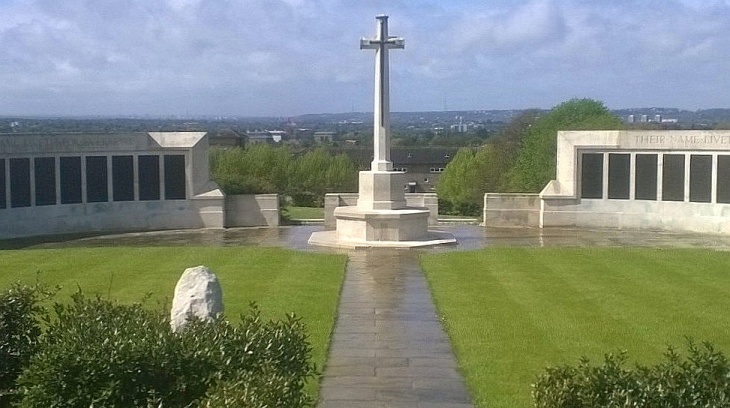
Greenwich Cemetery screen wall.
Greenwich Cemetery contains 560 First World War burials. More
than half of these graves are scattered throughout the cemetery, but
263 form a large war graves plot known as Heroes’ Corner.
Here, two curved screen walls bear the names of casualties buried
both in the plot and in unmarked graves in the cemetery.
――――♦――――
PERCY BADRICK
Rifleman, 2nd Rifle Brigade, service no. 45751.
Son of George and Louisa Badrick, of Charles Street, Tring.
Died of died of wounds on the 30th May 1918, aged 19.
Buried in Mont Huon Military Cemetery, Le Treport, France, grave ref.
VI. K. 13A.
From the Bucks Herald, 2nd November 1918.
“Much sympathy is felt also with Mr. and
Mrs. George Badrick of Charles-Street, in their loss of yet another
son in France − the second boy to lay down his life for the great
cause. In addition Mrs. Badrick has to mourn the loss of a son by
her first marriage, who died of malaria fever [Note] whilst on active
service.
Lance-Corpl. Badrick was a promising lad, who joined the
Colours a year ago on attaining the age of 18 years, and was
previously in the employ of the Great Western Railway at Paddington
Station, where he was greatly respected by all with whom he came in
contact. He joined the K.R.R., was subsequently transferred to the
Rifle Brigade, and was wounded and taken to hospital, where for a
time he made good progress, but a relapse setting in he died at the
47th General Hospital at Treport, on May 30. [Note]
The previous family casualties were − Pts. George Badrick,
Berkshire, killed in France, September 1916, and Driver Walter
Winfield, A.S.C., died of malaria in Salonica. Another son, Pte. T. Badrick, Herts Regiment, is in hospital suffering from gas, and
still another, Pte. G. Badrick, has been discharged through
disablement from injuries received in action.”
From the Tring Parish Magazine, July 1918:
“Percy Badrick A/L/CPL 2nd BN Rifle
Brigade, was not much more than twelve months working on the
railway.
When he joined up he was put in the rifle brigade and later promotes
to L/CPL. He had not been in France long, before he was
severely wounded when the enemy were making their thrust on Amiens.
Everything that could be done appears to have been done for him.
The Nurse who spoke of him as ‘such a nice patient, and always
grateful,’ had great hopes of his recovery. However, he passed
away peacefully in the hospital at Treport on May 29th. May
god, sustain George and Louisa and comfort them.”
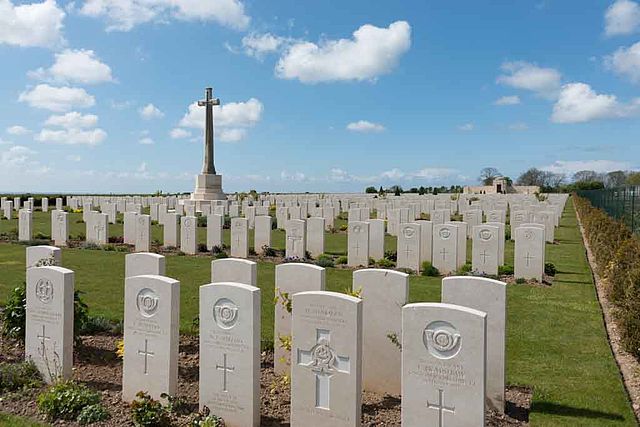
Mont Huon Military Cemetery.
During the war, Le Treport was an important military hospital
centre. No. 3 General Hospital was established there in November
1914, No. 16 General Hospital in February 1915, No. 2 Canadian
General Hospital in March 1915, No. 3 Convalescent Depot in June
1915 and Lady Murray’s B.R.C.S. (British Red Cross Society) Hospital
in July 1916. These hospitals contained nearly 10,000 beds.
No. 47 General Hospital arrived in March 1917 and later that year, a
divisional rest camp and a tank training depot were established in
the neighbourhood. All the hospitals had been closed by March
1919 and Le Treport became the headquarters of the 68th Division,
which re-formed there before going to the Rhine. The
divisional supply depot was closed in June 1919.
As the original military cemetery at Le Treport filled, it became
necessary to use the new site at Mont Huon. There are now
2,128 Commonwealth burials of the First World War in the cemetery
and seven from the Second World War. The cemetery also
contains more than 200 German war graves.
――――♦――――
WILL BAKER
Private, HQ (Portsmouth) Royal Marine Light Infantry, service number
PO/17360.
Son of Herbert H. Baker, of 46, Wingrave Rd., New Mill.
Died of typhoid (contracted in the Dardanelles) on 29th October 1915, aged 20.
Buried in Tring Cemetery, grave ref. E.18.
From the Bucks Herald, 30th October 1915:
“Military Funeral. Private Will Baker of
the Royal Marine Light Infantry, son of Mr Herbert Baker of New Mill
was invalided home from the Dardanelles with enteric fever
[typhoid] and died at his home on
October 21st. He was at one time a member of the Church Lads’
Brigade. It was decided to bury him with military honours and
the General at Halton Camp kindly supplied a gun carriage, firing
party and a band for his funeral. The coffin, covered with the
Union Jack, was escorted by the firing party with arms reversed from
Mr Baker’s home to the Parish Church, where it was met by the Rev. H.
Frances (vicar), the Rev. E. E. U. Bull, and the Rev. Guy Beech.
On the way from the church to the Cemetery the band played funereal
music, rendering ‘The Dead March’ as the cortège passed through the
Cemetery gates. After the committal the buglers sounded ‘Last
Post’ and three volleys were fired.”
In the 1911 Census Will’s occupation is given as Telegraph
Messenger.
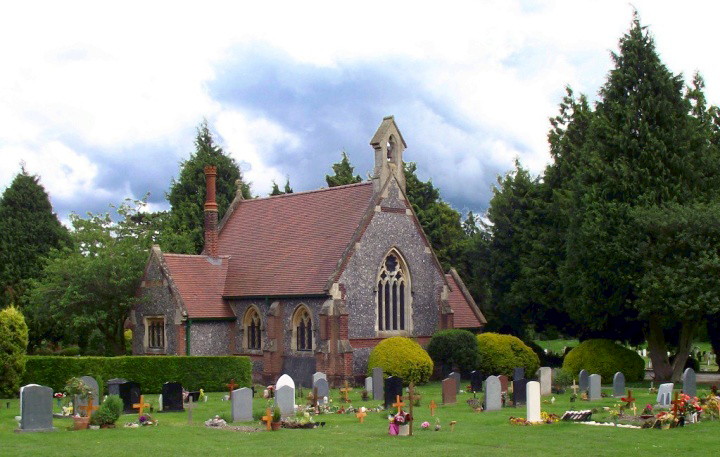
The chapel,
Tring Cemetery.
――――♦――――
ALBERT BANDY M.M.
Lance Corporal, 18th Bn. King’s Royal Rifle Corps, service no.
R/4994.
Born in Wing, Bucks, son of John Bandy of Albert Street, Tring.
Killed in action on the 23rd August 1918.
Buried in Achiet-Le-Grand Communal Cemetery Extension,
Pas de
Calais, France, grave ref. II. L. 13.
The 18th Battalion, Kings Royal Rifle Corps, was raised at Gidea
Park in London on the 4th of June 1915. After initial training
the Battalion joined the 122nd Brigade in the 41st Division.
They proceeded to France on the 3rd May 1916, landing at Le Havre.
During August 1918, the Battalion was in the Front Line in the
vicinity of Dickebusch in Flanders, Belgium (Dickebusch is a village
in West Flanders, some 3 miles South-West of Ypres). The
following extracts are from the Battalion War Diary covering the
23rd August, the date on which Lance-Corpl. Bandy was killed:
“FRONT LINE
10th August: the Btn. in accordance with orders
relieved the 15th Btn. Hampshire Regiment in the front line which
had been consolidated by them on the night of the 9th-10th August.
Casualties nil.
11th August: Early in the morning at about 3-30 the
enemy dropped a very heavy barrage of all calibres on our forward
system reaching as far back as the LA CLYTTE - DICKEBUSCHE ROAD.
This lasted about about one hour. The mist was very thick and no
enemy were seen although when the barrage had stopped a good deal of
shouting could be heard. At about 5am the enemy attacked and
succeeded in driving in out left Coy front. The post occupied by Lt.
Binns and his platoon was completely isolated and none came out but
one man who took a message to OC Coy reporting their danger. The
left front Coy. immediately reorganised in the #### [outfront ???]
here and delivered a counter attack which succeeded in drawing the
enemy from all the posts he had occupied with the exception of Lt
Binns’ Post which was some hundred yards in front of our wire and
strongly held by the enemy.
The attack on the right front was equally determined but not so well
organised with the result that it was beaten off although for some
time the left post on the Coy front was for some time engaged with
the enemy in front of them as well as behind.
The situation for this post was relieved by the initiative and
quickness of Sgt Humphrey, who was in command of the left support
platoon on the Right Coy. front. This NCO led part of his post in am
immediate charge upon the enemy in the hollow between his own post
and the front line post. They inflicted heavy casualties upon the
enemy with the sword and rifle and drove them out in front of the
front line. The enemy were in much greater numbers than he had at
his disposal. This NCO was severely wounded in the spine.
At about 8am the situation was reported
normal by patrols sent forward by the Support Companies. All
telephone communication was cut and inter communication had to be
carried on by runners. Casualties: 3 officers killed, 2 officers
wounded, 1 officer missing. 4 O.R. killed, 20 O.R. wounded, 19 O.R.
missing. Operation order no. 16 was issued with a continuation.
August 12th, 16th/17th: The relief was interfered with
to some extent by an enemy bombing patrol, which entered on of our
posts but was ejected by the 12th East Surrey Regt.
On relief we remained in the Reserve Area at ZEVELOTEN until the
night of the 16/17 when we were relieved by the 12th E. Surrey
Regiment and proceeded to the Rest Area in L25 & Area. Casualties
nil. Operation order no. 17 was issued.
REST AREA
August 17th, 21st/22nd: nothing to report, except an
inspection of the Battn by G.O.C. Division who congratulated the men
on their successful resistance to the enemy attack on the morning of
the 11th.
On the afternoon of the 21st operation order no. 18 was issued and
during the evening the Battn. moved up to the front line in relief
of the 15th Battn. Hampshire Regt. During the relief we had one
officer killed and one O.R. wounded.
FRONT LINE
22nd August: No action except slight enemy shelling.
No casualties.
23rd. August: A quiet day. No enemy action except
shelling. 2 O.R. killed.”
Lance-Corpl. Bandy is not named in the War Diary, so it must
be assumed that he was one of the “O.R.s” to fall on the 23rd
August. This from the Bucks Herald, 7th September 1918:
“ANOTHER LOCAL
HONOUR. – Pte. Albert Bandy, Machine
Gun Section, [Note] K.R. Rifles, son of Mr. John Bandy of Albert-street,
has received a notification that he is to receive the Military Medal
for gallant combat during the progress of the battle of the Somme.
The young fellow, who is well known locally, was chauffeur to Lady
Battersea, and was also known as a fine sportsman and winner of many
prizes in local sports, being a grand sprinter and highly proficient
in other athletic events. After joining up in the early years
of the war he took part in the regimental sports, and succeeded in
annexing nearly the whole of the chief prizes. At present he
is lying at a hospital in the North of England suffering from
injuries to his leg received in action, but it is pleasing to record
that he is making a good recovery. His many friends are proud
of the distinction conferred on him.”
From the Bucks Herald, 7th September 1918:
“Some 15 months ago we had much pleasure in
announcing the fact that Lance-Corpl. Albert Bandy, King’s
Royal Rifles (son of Mr. and Mrs. Bandy of Albert Street, formerly
of Aston Clinton), had been awarded the Military Medal for gallantry
in the field. With profound regret we have now to record the
fact that this gallant young fellow was killed in action in France
on August 23 last. The sad news was conveyed to his parents in
a letter received on Tuesday night from the Major of his regiment,
who expressed the great loss the Battalion had sustained, Lance-Corpl.
Bandy being held in the highest esteem by officers and men alike.
The deepest sympathy is felt for the family in their great trouble.”
From the Parish Magazine:
“His Major, writing to his mother says:
‘The battalion was engaged in one of the big battles recently fought
and gallantly achieved all that was asked of it. Your son
fought nobly and died a brave man’s death. His death is deeply
mourned in the battalion, by all of the officers and all his
comrades.’”
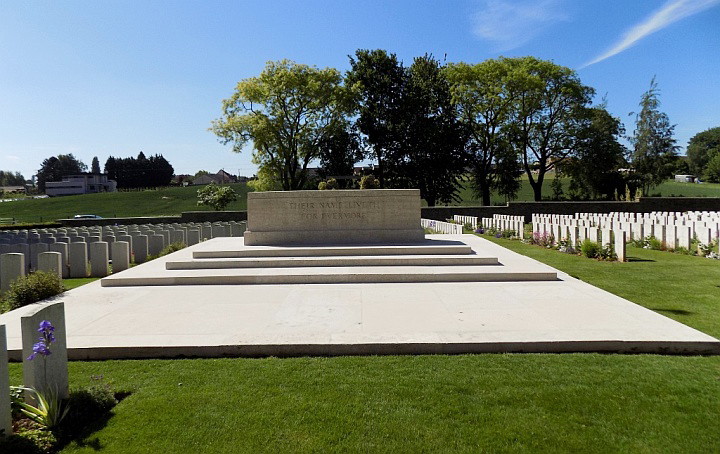
Achiet-Le-Grand Communal Cemetery
Extension.
Achiet-le-Grand was occupied by the 7th Bedfords on the 17th March
1917, lost on the 25th March 1918 after a defence by the 1st/6th
Manchesters, and recaptured on the 23rd August 1918.
From April 1917 to March 1918, the village was occupied by the 45th
and 49th Casualty Clearing Stations. Achiet station was an
allied railhead. The communal cemetery and extension were used
by Commonwealth medical units from April 1917 to March 1918.
The extension was also used by the Germans to a small extent in
March and April 1918, and again by Commonwealth troops in August
1918. After the Armistice Plot III and most of Plot IV were
made when 645 graves, mainly of 1916 and March and August 1918, were
brought in from the battlefields round Achiet and from other burial
grounds.
The Communal Cemetery contains four Commonwealth burials of the
First World War. The Extension contains 1,424 Commonwealth
burials and commemorations of the First World War. 200 of the
burials are unidentified but there are special memorials to eight
casualties known or believed to be buried among them. Other
special memorials commemorate ten casualties buried in other
cemeteries whose graves could not be found. There are also 42
German war graves in the extension.
――――♦――――
EDWARD BARBER V.C.
Private, 1st Battalion, Grenadier Guards, service no. 15518.
Son of William and Sarah Ann Barber of Miswell Lane, Tring.
Killed by sniper fire, Neuve Chapelle, France, (presumed on) 12th
March 1915, aged 22.
No known grave – commemorated on Le Touret Memorial, France, panel 2.
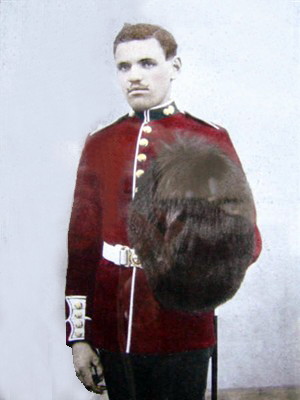
Barber’s father was employed at the Tring gas works while Edward was
a bricklayer’s labourer before joining the army at the age of 18.
An extract from The London Gazette,
dated 19th April, 1915, records his Victoria Cross citation:
“For most conspicuous bravery on 12th
March, 1915, at Neuve Chapelle. He ran speedily in front of
the grenade company to which he belonged, and threw bombs on the
enemy with such effect that a very great number of them at once
surrendered. When the grenade party reached Pte. Barber they
found him quite alone and unsupported, with the enemy surrendering
all about him.”
This from The Grenadier Guards in the Great War of 1914-1918,
by Lieut. Colonel The Right Hon. Sir Frederick Ponsonby:
“Meanwhile Private Barber advanced by
himself down one of the enemy’s communication trenches with a bag of
bombs: when a bullet from one of the enemy’s snipers struck the
bombs he was carrying, he threw them away, and they exploded.
Gathering up a fresh supply from a dead man, he rushed along,
throwing them with such effect that a large number of Germans put up
their hands and surrendered. He continued his advance until he
was shot by a sniper, and was responsible for taking over one
hundred prisoners. For this conspicuous act of bravery he was
awarded the Victoria Cross.”
The Battle of Neuve Chapelle took place between the 10th and 13th of
March, 1915. It was the first large scale organised attack
undertaken by the British Army during the war, and the first in
which a combined British and Indian force took part.
The object was to capture a German held salient, then the village of
Neuve Chapelle itself, and then drive through onto the nearby Aubers
Ridge. Here the high ground was of strategic value, its
capture making possible the disruption of enemy lines of
communication between La Bassee and Lille. Although
significant gains were made and the salient flattened out, the
Aubers ridge was not reached, hence the hoped for breakthrough could
not be made. 40,000 Allied troops took part in the battle.
Casualties were 7,000 British and 4,200 Indian, while German
casualties are believed to have been of similar number. The
British also captured 1,200 German troops.
From the
Bucks Herald, 17th April 1915:
“On Wednesday night news reached Tring of
the death of Privt. Edward Barber, V.C., of the Grenadier Guards.
Privt. Barber was the son of Mr. William Barber, of Miswell-lane,
Tring, who has three other sons on active service. The letter,
which was written by Lieut. Fulley, of No. 4 Company, 1st Batt.
Grenadier Guards, says that Barber was a great favourite with the
Grenadiers, and was highly respected. He had won the highest
honour that could be won, viz. the Victoria Cross, and while doing
his duty was picked off by a German sniper, the bullet piercing his
brain. He was a man of the finest courage and feared nothing.
The Grenadiers send their deepest sympathy.”
From the
Bucks Herald, 8th May 1915:
“All doubt as to the fate of Private Edward
Barber, V.C., who was reported missing, has now been set at rest.
His friends have been informed by the military authorities that he
was shot through the head, and that his body was not recovered from
the trenches.”
Three of Edwards brothers also served: Alfred in the R.A.M.C.,
William in the 1/1st Herts and Ernest trained with the 2/1st Herts
(266355), transferred to the 1/1st Bn. and was posted missing in
September 1917. He had been taken prisoner and was repatriated
in 1918 with arm injuries and partial paralysis. He died on
the 18th September 1920 − due to his wounds and the effect of
mustard gas − and is buried in Tring Cemetery, but his name does not
appear on the War Memorial.
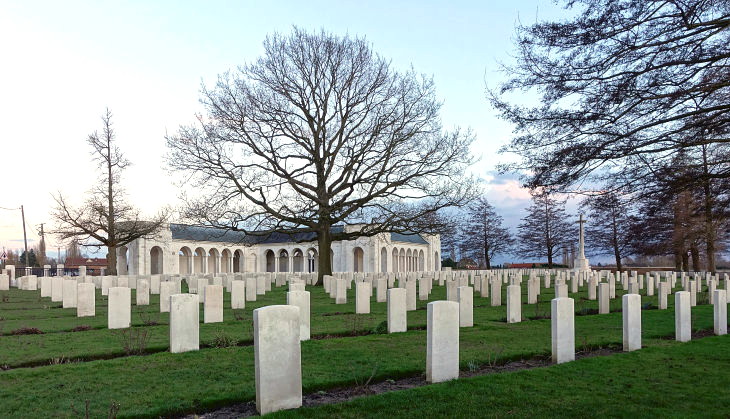
The Le Touret Memorial commemorates over 13,400 British soldiers who
were killed in this sector of the Western Front from the beginning
of October 1914 to the eve of the Battle of Loos in late September
1915 and who have no known grave. The Memorial takes the form
of a loggia surrounding an open rectangular court. The names
of those commemorated are listed on panels set into the walls of the
court and the gallery, arranged by regiment, rank and alphabetically
by surname within the rank. The memorial was designed by John
Reginald Truelove, who had served as an officer with the London
Regiment during the war, and unveiled by the British ambassador to
France, Lord Tyrrell, on 22 March 1930.
In October 1914, II Corps [Note]
of the British Expeditionary Force [Note]
moved north from Picardy and took up positions in French Flanders
where they were immediately engaged in the series of attacks and
counter attacks that would become known as the ‘race to the sea’. [Note]
Over the course of the next year most of the British activity in
this sector focused on attempting to dislodge the German forces from
their advantageous position on the Aubers Ridge and capture the city
of Lille, a major industrial and transport centre which the Germans
had occupied early in the war. The ridge is a slight incline
in an otherwise extremely flat landscape from which the Germans were
able to observe and bombard the British lines. Following the
British capture of the village of Neuve Chapelle in March 1915, the
Germans greatly strengthened their defences along the ridge,
reinforcing their positions with thick barbed wire entanglements,
concrete blockhouses and machine gun emplacements. These extra
defences frustrated British attempts to break through enemy lines
and led to very heavy casualties at the battles of Aubers Ridge and
Festubert in May 1915.
Almost all of the men commemorated on the Memorial served with
regular or territorial regiments [Note]
from across the United Kingdom and were killed in actions that took
place along a section of the front line that stretched from Estaires
in the north to Grenay in the south. This part of the Western
Front [Note] was the scene of some
of the heaviest fighting of the first year of the war, including the
battles of La Bassée (10th October–2nd November 1914), Neuve
Chapelle (10th–12th March 1915), Aubers Ridge (9th–10th May 1915),
and Festubert (15th–25th May 1915). Soldiers serving with
Indian and Canadian units who were killed in this sector in 1914-15
whose remains were never identified are commemorated on the Neuve
Chapelle and Vimy memorials, while those who fell during the
northern pincer attack at the Battle of Aubers Ridge are
commemorated on the Ploegsteert Memorial.
The men of the Indian Corps began burying their fallen comrades at
this site in November 1914 and the cemetery was used continually by
field ambulances and fighting units until the German spring
offensive began in March 1918. [Note]
Richebourg L’Avoue was overrun by the German forces in April 1918,
but the cemetery was used again in September and October after this
territory was recaptured by the Allies. [Note]
Today over 900 Commonwealth servicemen who were killed during the
First World War are buried here.
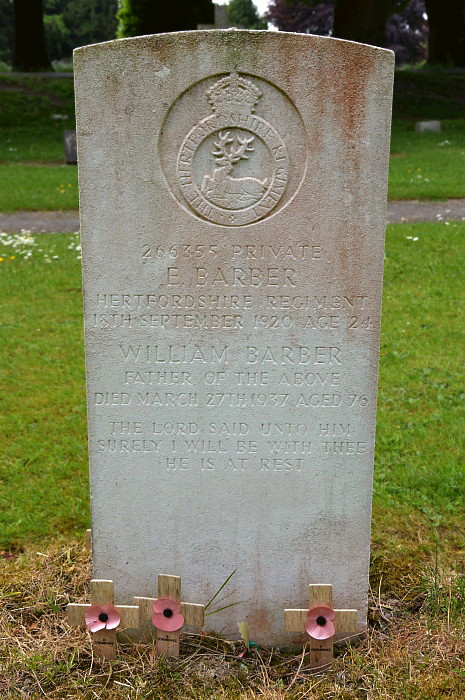
The grave of Private Ernest Barber,
brother of Edward.
Tring Cemetery.
――――♦――――
FRANK MANFIELD BATES
Private, 6th Somerset Light Infantry (formerly with the Herts
Regiment), service no. 26994.
Son of Manfield and Mary Louisa of 11 Henry Street.
Died of shrapnel wounds on 20th September 1916, aged 21.
Buried in Heilly Station Cemetery, Mericourt-L’Abbe, France, grave ref. IV.
E. 29.
Frank Bates appears in the 1911 Census as a Grocer’s Assistant.
In the following year he was awarded the Church Lads’ Brigade Medal
for 5 years service. Then, in 1914, his name appears in the
Parish Magazine among those from the Church Lads’ Brigade who
are on active service.
The 6th (Service) [Note] Battalion
Somerset Light Infantry was raised at Taunton in August 1914 as part
of Kitchener’s Army [Note] and was
attached to 43rd Brigade in the 14th (Light) Division. [Note]
They proceeded to France in May 1915 and served on the Western Front
[Note] throughout the war. In
1915 they took part in The Action of Hooge, in which the Division
became the first to be attacked with flamethrowers, [Note] and The Second
Attack on Bellewaarde. In 1916, in the Battles of the Somme,
they fought in Delville Wood and Flers-Courcelette, in which Private
Bates was fatally wounded.
The Battle of Flers–Courcelette – notable for being the first
action in which tanks were used – was a battle within the Somme
Offensive. Launched on the 15th September 1916, it was the
last general offensive mounted by the British Army (4th Army under
Rawlinson) during the Battle of the Somme. The objective was
to cut a hole in the German line with the use of massed artillery
and infantry attacks, which would then be exploited with the use of
cavalry. By its conclusion on the 22nd September, the
strategic objective of a breakthrough had not been achieved,
although tactical gains had been made with the capture of the
villages of Courcelette, Martinpuich and Flers, and in some places
the Allied attacks had advanced the front lines by some 2,500.
On the 14th September, the 6th Somerset L. I. was just south of Albert and
began to move up towards the front line. The Battalion
commander, Lieut.-Col. T. F. Ritchie, was told he was to attack the enemy
at 9.25 a.m. on 16th September. No time was given to the
Battalion for a reconnaissance of the ground over which the attack
was to take place, which resulted much confusion. The
artillery barrage [Note] was also
quite inadequate and heavy machine-gun fire met the advance with the
result that the attack broke down with heavy losses. This from
the History of the Somerset Light Infantry 1914-18 by Everard
Wyrall:
“The casualties of the 6th Battalion in
this affair were truly terrible. Every officer who went over
the parapet had become a casualty. Three had been killed, 12
wounded and 2 were missing. In other ranks the Battalion had
lost 41 killed, 203 wounded and 143 missing. The ridge between
‘A-A’ and ‘X-X’ Trenches was a veritable death trap, and here the
Somerset men, as they advanced, were shot down in dozens by German
machine gunners firing from the north and east.”
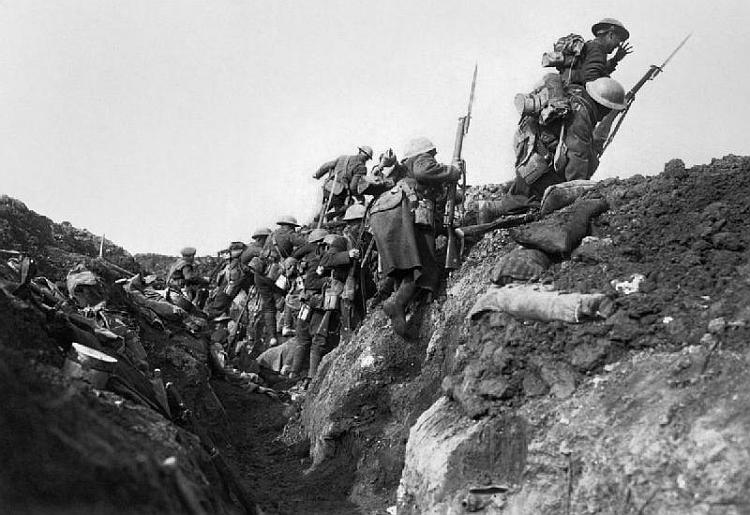
Over the parapet.
This from the 6th Battalion War Diary for 15th and 16th
September:
ALBERT – GUEDECOURT
15th September 1916
Bombs, 100 rounds S.A.A. [small arms ammunition]
per man & flares were issued. The Battn. moved off at 7.30 and
arrived Pommiers Redoubt at 9.30.
11.15 am: Orders received to occupy the check line in
front of Bernafay Wood.
2 pm: To occupy trenches which did not exist between
Delville Wood and the Switch trenches, men commenced digging
themselves in with their entrenching tools as no tools had arrived.
The Transport Officer later brought up the tools under heavy shell
fire.
11 pm: Orders received that we had to relieve the 42
Bgde in the front line, but first of all rations had to be fetched
about 2 miles back, parties were sent back at once to get rations
and water which had not been issued during the day.
16th September
1.30 am: No rations had arrived so we moved to the
front line and relieved the 42 brigade who had attacked in the
morning and had received heavy losses. The line was very vague
but we managed to get relief over just before daybreak.
4.15 am: Rations only arrived for 2 companies.
The other companies ate their iron rations. The worst
difficulty was water which was very scarce.
B C A companies attacked Gird Trench and Gird Support supported
by D Company but before reaching their first objective, they came
under heavy machine gun fire from both flanks which inflicted heavy
casualties upon us and we were obliged to dig ourselves in
without reaching the objective.
D Company was then sent to the front line but without any further
advance. The 6 KOYLI [King’s Own Yorkshire Light
Infantry] were then called up and kept in
reserve in our jumping off position.
Brigade asked us that if we thought it advisable we should attack
again at 4 pm, but as we considered it impossible nothing was done.
6.20 am: Orders were received that the remnants of the
battn and 2 companies of the 6 KOYLI would attack Gird Trench again
but owing to the short time given us it was found impossible to get
orders out, the 2 companies KOYLI attacked as they were already
formed up, and a proportion of our men who had received orders but
the barrage was again very feeble and heavy machine gun fire was
turned on to us, with the result that the attack again broke down
with heavy losses. Night had then commenced and parties
were sent out to try and collect the various small parties and
consolidate the ground won. After great difficulty the trench
was discovered. Enough men were collected to hold with the
help of one company of the KOYLI. This line was then held and
consolidated until relieved by the 13th Batt. Northumberland
Fusiliers in the early hours of the morning, just enable the
remnants of the battn to get clear over the crest of the hill by
daybreak. Our casualties were every officer who went over
the parapet 3 were killed, 12 wounded, 2 are missing. Other ranks
casualties were 41 killed, 203 wounded, 143 missing. Operation
Orders enclosed with full account.
From the Bucks Herald, 7th October 1916:
“Frank Bates, who died from wounds on
September 20, was the son of Mr. Mansfield Bates, and is another of
the Tring lads who at the beginning of the war joined the County
Regiment. He was a choirboy at the Parish Church, and an
active member of the Church Lads’ Brigade. He was a steady,
amiable boy, and generally liked. He was with the B.E.F. in
France, and about a week before his death was transferred from the
Herts. Regiment to the Somerset L.I. The Rev. Canon R. A.
Adderley, C.F., writing to his parents, says he was admitted to the
Hospital [Note] suffering from shell wound in the abdomen, and that he
passed away on the 20th. He was buried at Heilly military
cemetery on September 21. Frank Bates was well known and
greatly liked in the town, and his death is much regretted.”
From the Parish Magazine, November 1916:
“Frank Bates, Hertfordshire Regt, was
admitted to hospital on September 16th, suffering from shrapnel
wounds. From there he managed to write a cheery letter home (his
thoughts were always there) but four days later he died “a good
soldier of Jesus Christ”, as the chaplain (The Rev Canon R.A.
Adderley) who wrote to his friends expressed it. He was buried, the
following evening in a grave behind the lines.
For
several years, Frank sang in the choir at the parish church and
joined “The church lads brigade” as soon as he was old enough. To
the end, he remained a keen and loyal member. He will be
affectionately remembers in Tring and we shall miss him when the
boys come home. R.I.P.”
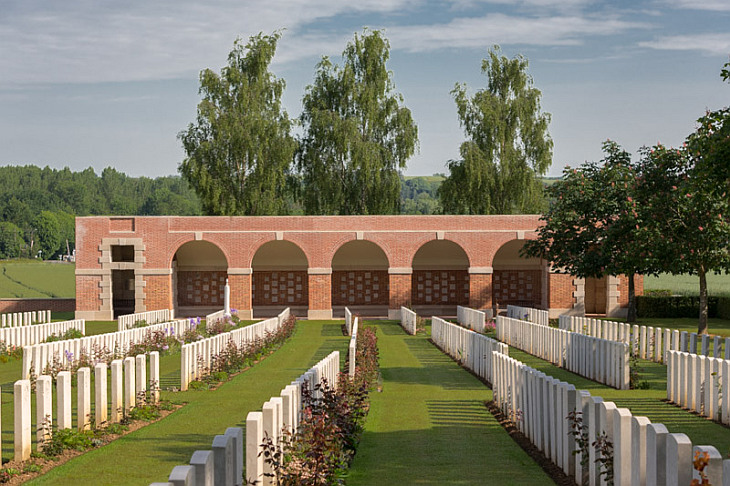
The 36th Casualty Clearing Station [Note]
was at Heilly from April 1916. It was joined in May by the
38th, and in July by the 2/2nd London, but these hospitals had all
moved on by early June 1917.
Heilly Station Cemetery was begun in May 1916 and was used by the
three medical units until April 1917. From March to May 1918,
it was used by Australian units, and in the early autumn for further
hospital burials when the 20th Casualty Clearing Station was there
briefly in August and September 1918. The last burial was made
in May 1919.
There are now 2,890 Commonwealth servicemen of the First World War
buried or commemorated in this cemetery. Only 12 of the
burials are unidentified and special memorials are erected to 21
casualties whose graves in the cemetery could not be exactly
located. The cemetery also contains 83 German graves. The
burials in this cemetery were carried out under extreme pressure and
many of the graves are either too close together to be marked
individually, or they contain multiple burials. Some
headstones carry as many as three sets of casualty details, and in
these cases, regimental badges have had to be omitted. Instead,
these badges, 117 in all, have been carved on a cloister wall on the
north side of the cemetery.
――――♦――――
RALPH BERTRAM BATTSON
Driver, 31st Royal Field Artillery, [Note] 31st Ammunition Column, service
no. 85758.
Son of Eleanor Prior (formerly Battson) and the late Benjamin of 16
Langdon Street.
Died of wounds on 15 May 1917 aged 21.
Buried in Duisans British Cemetery, Etrun, Pas de Calais, France, grave ref.
IV. G. 53.
Ralph Battson was born in Tring. The 1911 Census lists him as
a bookstall keeper, but at some time he was also employed locally by
Mr. A. P. Boyson, of Grove Lodge. Ralph enlisted in London in
August 1914. Three years later he was fatally wounded by shell
fire some miles behind the line.
From the Parish
Magazine, June 1917:
“Ralph Bertram Battson has been in France
for nearly two years. Even before the war broke out, he was eager
to be a soldier, and when a small boy, joined our Church Lad’s
Brigade of which, he was always a keen and smart member. In August
1914, he joined up, keen to do his bit. He was often complemented
on the care he took of his horses.
One of
the nurses from a casualty clearing station, writes, ‘he was brought
in there, dangerously wounded in the head and leg, all that could be
done, was done, and he had every care and attention. But in vain,
he died peacefully on the 15th May and was to be buried in a
cemetery nearby.’”
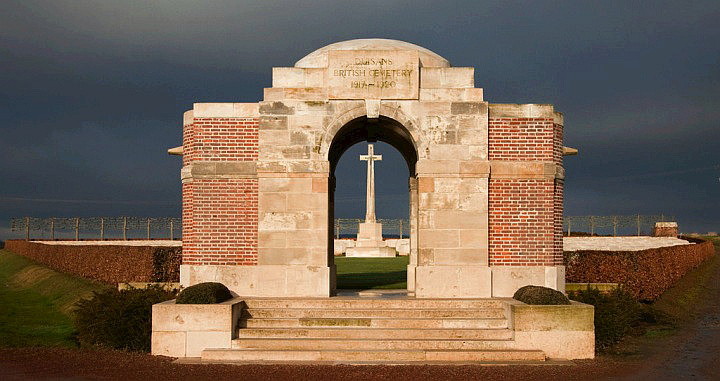
Duisans British Cemetery, Etrun, Pas de Calais.
The area around Duisans was occupied by Commonwealth forces from
March 1916, but it was not until February 1917 that the site of this
cemetery was selected for the 8th Casualty Clearing Station.
The first burials took place in March and from the beginning of
April the cemetery grew very quickly, with burials being made from
the 8th Casualty Clearing Station (until April 1918), the 19th
(until March 1918), and the 41st (until July 1917). Most of
the graves relate to the Battles of Arras in 1917, and the trench
warfare that followed. From May to August 1918, the cemetery
was used by divisions and smaller fighting units for burials from
the front line. In the Autumn of 1918 the 23rd, 1st Canadian and 4th
Canadian Clearing Stations remained at Duisans for two months, and
the 7th was there from November 1918 to November 1920.
There are now 3,207 Commonwealth servicemen of the First World War
buried or commemorated at Duisans British Cemetery. There are
also 88 German war graves.
――――♦――――
WILLIAM CHARLES BIRCH
Private, 1st Border Regiment, service no. 9781.
Born in Tring, son of Herbert of 2 Goldfield Cottages, Miswell Lane.
Killed in action in the Dardanelles on 28th April 1915 aged 20.
No known grave. Commemorated on the Helles Memorial, Turkey,
Panel 120
to 126 or 222 and 223.
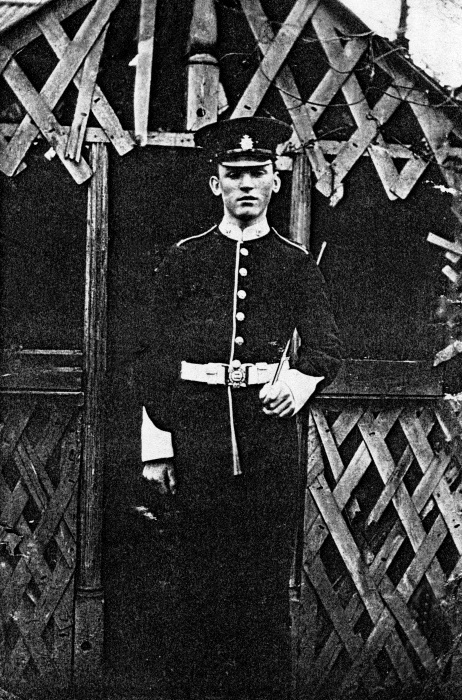
The eight month campaign in Gallipoli was fought by Commonwealth and
French forces in an attempt to force Turkey out of the war, to
relieve the deadlock of the Western Front [Note] in France and Belgium, and
to open a supply route to Russia through the Dardanelles and the
Black Sea.
The Allies landed on the peninsula on 25th-26th April 1915; the 29th
Division at Cape Helles in the south and the Australian and New
Zealand Corps north of Gaba Tepe on the west coast, an area soon
known as Anzac. On 6th August, further landings were made at
Suvla, just north of Anzac, and the climax of the campaign came in
early August when simultaneous assaults were launched on all three
fronts. However, the difficult terrain and stiff Turkish
resistance soon led to the stalemate of trench warfare. From
the end of August, no further serious action was fought and the
lines remained unchanged. The peninsula was successfully
evacuated in December and early January 1916.
The following extract is taken from the Battalion War Diary
covering the engagement fought on the 28th April:
GALLIPOLI, April 1915
27th April: The Battn. continued to hold the same line
& the day passed much as the previous one had done, no fighting but
continual sniping. Soon after midday it was seen that our
infantry was on the point of capturing Hill 138 & shortly afterwards
this was accomplished & a Field Battery opened on the enemy as they
retired by the E. Krithia nullah [a watercourse,
riverbed, or ravine] in the direction of
Achi Baba. All sniping at once ceased & all pressure on the
line by the enemy relaxed. Parties were sent out to
reconnoitre the places from which most of the sniping had come & it
was found on investigation that the enemy had suffered severely,
from 20 to 30 dead being counted in the valley previously referred
to & in the SNIPERS HUT N of it.
5pm: verbal orders were received from the Brigade to pivot
round the portion of the line that bent S from A Coy right &
establish one running almost due E from A Coy right through the
SNIPERS HUT where the 1/R Innis Fus [Royal Inniskilling
Fusiliers] would continue it up to the
KRITHIA main road the 88th Bde & the French prolonging the line from
the road to ESKI HISSARLIK on the W coast. This order
necessitated the digging of fresh trenches by C & D Coys & the men
being thoroughly tired out with hard work & hard fighting the
process was naturally slow but was however safely accomplished by
midnight. The enemy were quiescent during the night.
28th August: 2am – the following orders were
received from Bde HQ:– The Bde will advance at 8am. The
objective of the Bde is a line running from sq 176F through pt 472
(exclusive) to 184 R8. Operation order 201 by Lt. Col. R. O.
C. HUME based on the above was #### to coys at 7.45am.
8am: The advance started A &
B Coys firing line & supports C & D Coys & MGS in reserve.
Previous to advance starting a fairly accurate shell fire opened on
our trenches & immediately on troops quitting their trenches this
increased in intensity. The formation adopted was lines
of platoons in file at 100 yds interval & 300 yds distance between
firing line & supports & supports & reserve. The nullah
500 yds N of our trenches was crossed without opposition from the
enemy’s infantry & the forward movement up spur running N.N.E. from
175 Y continued. Meanwhile the R. Innis Fus who were
advancing up the spur on the S.E. side of the nullah had come under
heavy rifle & MG fire & it was evident that if we were to assist
their advance we must get forward at least
another mile.
11am: The advance was accordingly continued & by 11am two
platoons of B Coy and two platoons of A established themselves in
the old KOSB [The King’s Own Scottish Borderers]
trenches in sq 176 L. Here they came under a galling fire from
the bluff to the N & from forward slope of ridge NW of KRITHIA.
Owing to the conformation of the ground it was impossible to reply
to this fire. Accordingly the two platoons of B Coy worked
round the edge of the cliff & advanced some 300 yds & formed a
firing line across the ridge overlooking the opposite valley. The
two platoons of A Coy conformed to this movement moving by the edge
of the nullah.
11.30am: About this time lines of the enemy were observed
returning over the ridge N.W. of KRITHIA & all available rifles were
brought to bear on them at 1000 yds. Almost simultaneously a
terrific rifle & MG fire was opened on our firing line by the enemy
from well concealed trenches & emplacements of the N side of the
valley which crossed our front at a range of about 600 yds.
Casualties occurred at once & soon became extremely high.
Urgent messages were sent back from the firing line for
reinforcements but meanwhile the supports of A & B Coy & the two
reserve Coys had been held up by heavy shell fire & also by MG &
rifle fire from the high ground above KRITHIA. After
considerable delay supports began to arrive but these suffered
heavily in getting into the firing line as both the edge of the
cliff & the side of the nullah were taken in enfilade [Note]
from the enemy’s position.
1pm: The bulk of the Reserve had now worked up a small
nullah some 200 yds S of the first line of KOSB trenches & the sides
of the cliff & nullah being now impracticable as a line of advance
owing to the intensity of the fire, these were collected just below
the crest line & led forward in one rush into the firing line.
1.20pm: The enemy who were obviously in vastly superior
numbers now started to advance to closer range under a very heavy &
accurate covering fire. About this time casualties among
officers began to occur & MAJOR G. C. BROOKE, CAPT. R. HEAD, CAPT.
S. H. F. MURIEL & LT R. B. TAYLOR were all shot [dead]
within a few hundred yards of one another & LTS DINWIDDIE, CLAGUE &
MAY wounded.
2pm-4pm: CAPTS. MORTON & MOORE had
up to this time by their splendid example of coolness and courage
kept the firing line steady but suddenly the order to “Retire” was
shouted from the right flank & a somewhat precipitate retirement set
in. Most of the wounded men who could move got away down the
side of the cliff onto the beach. It was with great difficulty
& chiefly owing to the gallant exertions of COL R. O. C. HUME, CAPT.
G. A. MORTON & other officers that the firing line was again rallied
[on the top of the cliff] & a fresh defensive line some 200 yds S of
the KOSB old trenches taken up.
3pm: Much needed support in the shape of a Bttn of RND
[Royal Naval Division] arrived about
this time & helped materially to restore the situation & a bit later
a Coy of the S.W.B. [South Wales Borderers]
from the E side of the nullah came up as a reinforcement. COL
R. O. C. HUME whilst conferring with the O. C. R.N.D. & other
officers as to the situation was unfortunately badly hit & had to be
carried out of action leaving CAPT. G. A. MORTON in command.
[Col. Hume died May 1st]
4pm-Midnight: The violence of the enemy's attack now
relaxed considerably & CAPT. MORTON was able to select & entrench a
defensive line extending from from the cliff edge to the nullah, one
Coy RND holding the front line & the Battn two successive lines in
close support & one Coy 1/R Innis Fus sent across from E side of
nullah in Reserve. Our casualties were 4 officers & 37 men killed
& 5 off. & 152 R&F wounded & 10 R&F missing.
From the Bucks Herald, 29th May 1915:
“ANOTHER TRING
MAN KILLED. −
Tring’s Roll of Honour steadily grows. The latest name to be
added is that of William Charles Birch, of Miswell-lane, who is well
remembered in the town. William Birch belonged to the Border
Regiment, with which he was for some time in India. Soon after
the outbreak of war the regiment returned home, and afterwards went
out with the Mediterranean Expedition. While with this
expedition William Birch was killed in action at the Dardanelles on
May 14th. No details as to how he met his death have yet been
received in Tring. He was formerly a member of the Tring
Company Church Lad’s Brigade.”

The Helles Memorial serves the dual function of Commonwealth battle
memorial for the whole Gallipoli campaign and place of commemoration
for many of those Commonwealth servicemen who died there and have no
known grave. The United Kingdom and Indian forces named on the
memorial died in operations throughout the peninsula, the
Australians at Helles. There are also panels for those who died or
were buried at sea in Gallipoli waters. Over 20,000 names are
commemorated on this memorial.
――――♦――――
HENRY BRACKLEY
Gunner, 76th Siege Battery, Royal Garrison Artillery, service no.
134574.
Born in Wendover, Bucks. Enlisted at Tring.
Died of wounds on the 24th March 1918.
Buried St Hilaire Cemetery, Frévent, Pas de Calais, France, grave ref. IV.
A. 1.
Grave inscription: OUT OF SIGHT BUT NOT OUT OF MIND. NANCE
Private Brackley served with 76th Royal Garrison Artillery Siege
Battery. [Note] Royal
Garrison Artillery. Siege Batteries consisted of the largest
guns and howitzers, mounted on fixed concrete emplacements or
railways, and were consequently more or less static.
The 76th Siege Battery, RGA was formed at Harwich in August 1915.
Half of its officers and men were drawn from the Essex and Sussex
RGA (Territorial) and the other half from individuals serving in the
Regular Army, the Special Reserve and the New Army. [Note]
In December 1915 the battery moved to Lydd for training. On
the 15th March 1916 the battery left Lydd to mobilize at Bristol and
then moved to Southampton for shipment to France, landing at Le
Harve the 29th March. On the 2nd April 1916 the battery moved
to Albert where it was assigned to the 25th Heavy Artillery Group
(HAG) in the 10th Corps [Note]
and fought on the Somme [Note] from
May 1916 to March 1917.
In March 1917 the Battery moved to the Arras sector and took up
positions at Maroeuil near the Arras - St. Eloi road. In this
position it came under the command of the 13th HAG under the
Canadian Corps. It took part in the battle for Vimy Ridge.
On the 17th May it transferred to the 50th HAG and in late
May the battery moved to the Ypres Salient were it came under the
70th HAG, and later the 90th HAG.
On the 3rd March 1918 the battery was once again on the move,
returning to the Somme where it took up positions near Hermies, not
far from the main Bapaume-Cambrai road. On the 22nd March 1918
the battery took part in the retreat caused by the German March
Offensive, [Note] – Gunner
Brackley was fatally wounded at this time – ending up near
Albert for a few days and then moving again, finally taking up
positions at Herissart, ten miles west of Albert on the 11th April.
The Allied offensive in the later part of 1918 [Note]
caused the battery to move to Mesnil near Hamel, to Bellacourt, to
St. Ledger, Pronville (a strong point in the Hindenburg Line) and
then to Cambrai where it remained until the Armistice.
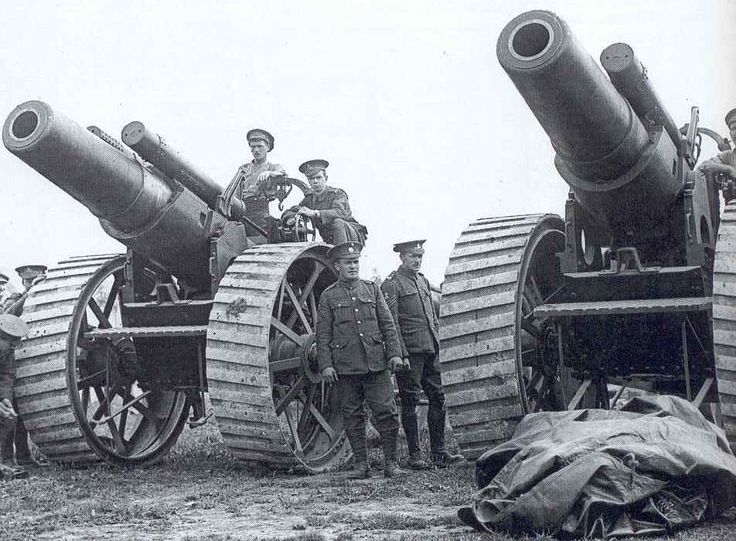
8-inch siege guns, Royal Garrison
Artillery (RGA) on the Somme. [Note]
From the Parish Magazine:
“Harry Brackley R.G.A. died on March 24th
in the 6th stationary hospital (France) [Note] where he had been brought
the previous day with a severe wound to the chest. He joined
the army in December of 1916 and last September went to France where
he as been ever since. He leaves behind him here the memory of a
straight and faithful life acknowledged by all who knew him.
R.I.P.”
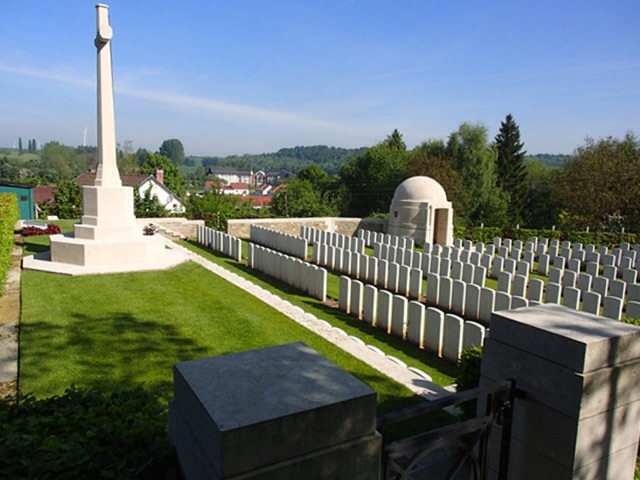
From its position, Frévent was a place of some importance on the
lines of communication during the First World War. The 43rd
Casualty Clearing Station was posted there from April to June 1916;
part of the Lucknow Casualty Clearing Station in June; the 6th
Stationary Hospital from June 1916 to the end of August 1918;
and the 3rd Canadian, 19th and 43rd Casualty Clearing Stations in
the summer of 1918. The great majority of the burials in the
cemetery were carried out from these hospitals.
The St Hilaire Cemetery now contains 210 Commonwealth burials of the
First World War and there are also 12 Second World War burials, all
dating from late May/early June 1940 and the withdrawal of the
British Expeditionary Force ahead of the German advance.
The Cemetery Extension contains a further 304 First World War
burials.
――――♦――――
THOMAS BRACKLEY
Private, 1st Grenadier Guards.
Son of James and Elizabeth Brackley, Marsh Croft, Tring.
Killed in action at the River Lys, Battle of Loos, 17th October
1915.
No known grave. Commemorated on the Loos Memorial, France, panel 5 to
7.
The Battle of Loos was a Franco-British action that took place
between 25th September and the 13th October 1915. The object
was to push the German army out of France before the onset of
winter. It failed. Sir John French, [Note] the
Commander-in-Chief of the British Expeditionary Force, was replaced
shortly after by Sir Douglas Haig. [Note]
The battle was the first in which the British used chlorine gas.
In places the gas hung between the lines or blew back into British
positions with damaging results. The casualties on the first
day were the worst yet suffered in a single day by the British army,
including some 8,500 dead.
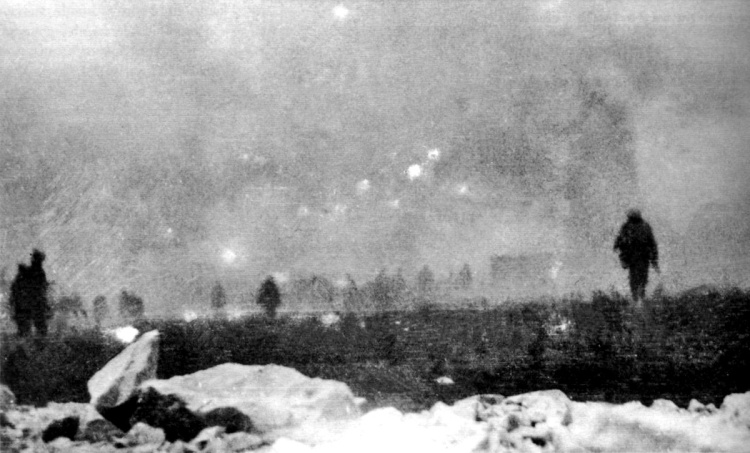
British troops advancing through smoke
and gas on the first day of the Battle of Loos.
This from The Grenadier Guards in the Great War of 1914-1918,
by Lieut. Colonel The Right Hon. Sir Frederick Ponsonby:
“During October the 1st Battalion remained
either in or just behind the trenches until the 26th. The
casualties in the other battalions necessitated a certain
redistribution of the officers, and Captain R. Wolrige-Gordon, who
had returned from sick leave, was transferred to the 3rd Battalion,
while Captain Greville and Second Lieutenant F. G. Bonham-Carter
went to the 4th Battalion.
On October 3 the 1st Battalion relieved the Oxfordshire and
Buckinghamshire Light Infantry in the trenches, and came in for a
good deal of shelling, during which it had twenty-six casualties.
On the 6th it was relieved by the 6th Buffs, and went into billets
at Vermelles, where it lived in cellars . . . .
On the 14th the Battalion moved up into the trenches near the
Hohenzollern Redoubt and occupied the front line south-east of ‘Big
Willie,’ the name given by the men to the largest of the two German
trenches connecting the Hohenzollern Redoubt with the main line of
the German trenches.
On the 17th Lieut. Colonel G. Trotter received orders to direct a
bombing attack against the German line towards Slag Alley. The
attack was to be undertaken by No. 3 Company under Lieutenant O.
Wakeman, and the men went out over the top with the expert bombers
leading, but on arrival they found two German machine-guns
enfilading the front of the German block. Second Lieutenant
the Hon. I. Charteris and Second Lieutenant H. Alexander, two very
promising officers, were killed at once, large number of men were
killed and wounded.
Lieutenant O. Wakeman behaved with greatest gallantry, and went
forward to see whether anything could be done. He found that
to attempt an advance was impossible, and was just sending back for
more reinforcements when he was shot through the top of the skull
and was completely paralysed in both legs. Colonel Trotter now
sent up Lieutenant Lord Lascelles to take command of the Company,
telling him, if possible, to keep all that had been gained, but to
use his discretion as to what should be done in the circumstances.
Lord Lascelles, on coming up, quickly grasped the whole situation.
He saw that while the two German machine-guns were in position, it
was a practical impossibility to take the trench, and he very wisely
withdrew what remained of that Company to our trenches. It was
well that he did so, for soon afterwards the Germans commenced a
heavy bombardment, which lasted till noon. The casualties
were 2 officers killed and 3 wounded, with 125 of other ranks killed
and wounded.”
From the Bucks Herald, 28th October 1916:
“Tom Brackley enlisted in September, 1914,
in the Grenadier Guards. He has been missing since October 17,
1915. The authorities have communicated with his parents to
the effect that he was supposed to have been killed on that day in
the Guards’ assault on Hulluck. Tom is remembered here as a
brave boy, full of Hope.”
From the Parish Magazine, November 1916:
“Tom Brackley, Grenadier Guards has been
missing since October 17th 1915, is now supposed by the War Office
to have been killed on that day in the guards assault on Hulluch,
and an intimation to this effect has been received by his parents.
It is sad to think that we will never, probably, know any further
details of his death, but we may be sure he did his duty manfully
and he is one of those whom we in Tring shall remember with pride
and gratitude.”

The Loos Memorial.
The Loos Memorial forms the sides and back of Dud Corner Cemetery,
which stands near the site of a German strong point, the Lens Road
Redoubt, captured by the 15th (Scottish) Division on the first day
of the battle. The Memorial commemorates over 20,000 officers
and men who have no known grave and who fell in the area from the
River Lys to the old southern boundary of the First Army, east and
west of Grenay, from the first day of the Battle of Loos to the end
of the war. |

War gratuity paid in 1919 to Thomas’s
father, James.
――――♦――――
WILLIAM BRANDON
Private, 27th Bn. Canadian Infantry, City Of Winnipeg Regiment,
service no. 72145.
Eldest son of Frederick and Ellen Brandon of 24 Henry Street, Tring.
Killed in action on 4th April 1916 aged 21.
No known grave. Commemorated on the Ypres (Menim Gate)
Memorial,
Belgium,
panel 24-26-28-30.
The name listed on the Tring War Memorial is that of William
Brandom. Lance Sergeant William Brandom of the 2nd Bn. Bedfordshire Regiment
was killed in action during the Battle of Loos, but he appears to
have no Tring connections. It is likely that the name on the
Memorial is
misspelt, and that which should appear is of Private William Brandon
of the 27th Bn. Canadian Infantry. William enlisted in the
Canadian Army in March 1915 and was sent to England in May of that
year.
The 1911 Census shows
William, then aged 16, living with his parents in Henry Street and
employed as an Assistant Postman.
In
1912 William and a number of other Tring Lads emigrated to Canada
under a scheme sponsored by Lord Rothschild. This from the Bucks Herald, 27th April 1912:
“OFF TO CANADA.
On Wednesday evening April 24th, two more young fellows left Tring
to seek their fortunes out West. They sailed on the 25th by
the Canadian Pacific liner Champlain. W. Poulton is bound for
Winnipeg, and Gilbert Waring is going back to join his brother, who
will be remembered as half-back in the Tring football team, at
Vancouver, British Columbia. On Thursday night, the 25th,
another detachment left to catch the 12 midnight express for
Liverpool, where the next day they embarked on the Allan liner
Virginian en route for Winnipeg. The party included Mrs
Cartwright, widow of a former bell ringer at the Parish Church, who,
with her family, is going to join two of her sons and a daughter,
who have been settled out there for some time; J. Anderson and W.
Fenn, two old Church Lads Brigade members and W. Brandon. Lord
Rothschild generously paid the passage in each of these cases and
the bookings were made through Messrs C. Griffin and Son, of Tring.”
The 27th Battalion (City of Winnipeg) was an infantry battalion of
the Canadian Expeditionary Force. Authorized on the 7th November
1914, the Battalion embarked for Great Britain on the 17th May 1915
and, following training, landed in France on the 18th September,
where it fought on the Western Front [Note]
as part of the 6th Infantry Brigade, 2nd Canadian Division [Note]
until the end of the war.
The action in which Private Brandon was killed was that known as The
Action of St Eloi Craters (27th March–16th April 1916). St
Eloi lies on the road running south from Ypres in the direction of
Messines. Here, an awkward trench salient poked into British
positions with the enemy on slightly higher ground – including an
artificial earth bank called “The Mound” – that gave the
Germans excellent observation over British trenches and roads.
This had been the scene of almost continuous mine warfare [Note]
during 1915, with both sides actively engaged. In all some 33
surface mines had been exploded within a small area, of which the
Germans had fired the majority. This is where the 27th Bn.
Canadian Infantry found themselves on the 4th April, the day on
which Private Brandon was killed – this extract is from their
War Diary:
“METERN
1-4-16: Battalion in rest Camp at Metern. Weather fine & dry.
‘A’ and ‘C’ Companies and Headquarters moved to La Clytte. ‘B’
& ‘D’ Coys remained at Metern in Corps Reserve & carried out
training.
LA CLYTTE
2-4-16: Weather fine and clear. Headquarters, ‘A’ & ‘C’
Coys in Brigade Reserve La Clytte. ‘B’ & ‘D’ Companies moved
to B Camp (M6a4.7) #### 28, leaving Metern at 8.30am. During
forenoon 6 officers & 6 NCOs of ‘A’ & ‘C’ Coys reconnoitred trenches
25-28 (0.3 t). These trenches were not the ones subsequently
occupied by the Battalion. ‘A’ Coy. and 2 platoons of ‘C’ Coy.
relieved 6 platoons of 18th Cdn. Inf. Battalion in P trenches viz.
P1 to P A B and S.P.8. See battalion Operation Orders No. 37
Appendix 1. These Platoons were heavily shelled.
TRENCHES
3-4-16: Weather still fine. “B” & “D” Coys. & remaining 2
platoons of “C” Coy. & Headquarters left Camp at 13
[???]
Camp Billets at La Clytte at 5pm to take over trenches in front of
St. Eloi. See Battalion Operation Orders No. 38 Appendix 2.
Casualties Lieut. A. Z. MIDDLETON and 4 other ranks wounded.
4-4-16: Weather still fine – Casualties, killed 13 O.R.,
wounded 46 O.R., missing 4 O.R.
5-4-16: Weather still fine – Casualties, killed 1 O.R.,
wounded 2 O.R.
6-4-16: Weather fair but rained during night – Casualties,
killed Lieut. R. E. N. JONES, wounded Lieut. A. B. IRVINE, Lieut. J.
DUNLOP, Lieut. H. J. RILEY, Lieut. S. P. LOUGH. Missing Lieut. D. W.
ELLIOTT. Other ranks, killed 15, wounded 122, missing 5.
7-4-16: Weather fine. Casualties OR wounded 11.
Relieved by 21st Cdn. Inf. Battalion. A summary of operations
from April 1st 1916 to Apr. 7th 1916 by Lieut.-Col. I. R. Snider O.C.
the Battalion is attached & marked Appendix III
[see
next]
. . . .”
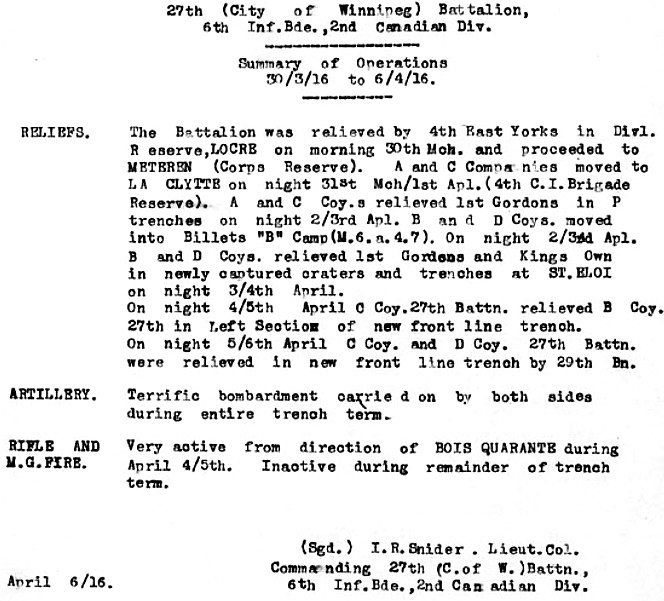
27th Battalion War Diary Summary of
Operations 30-3-16 to 6-4-16.
From the Bucks Herald, 22nd April 1916:
“ANOTHER TRING
LAD FALLS IN ACTION.
-- The most recent addition to Tring’s Roll of Honour is the name of
Private Wm. Brandon of the Canadian Contingent. William
Brandon was the son of Mr. and Mrs. Fredk. Brandon of Henry-street,
Tring, and was 21 years of age. He enlisted in the Canadian
Army in March, 1915, and was drafted to England last May.
After being in the Old Country a few months, he was sent to France,
and remained there until his death, which occurred on April 4.
The letter received by his parents on Sunday morning states that he
was killed in action by a shell. He was respected by all who
knew him, and will be greatly missed by all his comrades. His
parents have received the assurance of the King’s sympathy in their
sad bereavement, and this they greatly appreciate. Private W.
Brandon was well known in Tring and general regret is expressed at
this early closing of his career. A younger brother joined the
Army a day or two before the news was received of Private Brandon’s
death.”

Interior of the Menim Gate Memorial.
From October 1914 to October 1918, five major offensives occurred at
Ypres in Belgium. By the time the last shells fell in Ypres in
October 1918, nearly 200,000 Commonwealth servicemen had been
killed.
The Menin Gate is one of four memorials to the missing in Belgian
Flanders which cover the area known as the Ypres Salient.
Broadly speaking, the Salient stretched from Langemarck in the north
to the northern edge in Ploegsteert Wood in the south, but it varied
in area and shape throughout the war. The Salient was formed
during the First Battle of Ypres in October and November 1914, when
a small British Expeditionary Force [Note]
succeeded in securing the town before the onset of winter, pushing
the German forces back to the Passchendaele Ridge. The Second
Battle of Ypres began in April 1915 when the Germans released poison
gas into the Allied lines north of Ypres. This was the first
time gas had been used by either side and the violence of the attack
forced an Allied withdrawal and a shortening of the line of defence.
There was little more significant activity on this front until 1917,
when in the Third Battle of Ypres an offensive was mounted by
Commonwealth forces to divert German attention from a weakened
French front further south. The initial attempt in June to
dislodge the Germans from the Messines Ridge was a complete success,
but the main assault north-eastward, which began at the end of July,
quickly became a dogged struggle against determined opposition and
the rapidly deteriorating weather. The campaign finally came
to a close in November with the capture of Passchendaele. The
German offensive of March 1918 [Note]
met with some initial success, but was eventually checked and
repulsed in a combined effort by the Allies in September. [Note]
The battles of the Ypres Salient claimed many lives on both sides
and it quickly became clear that the commemoration of members of the
Commonwealth forces with no known grave would have to be divided
between several different sites. The site of the Menin Gate
was chosen because of the hundreds of thousands of men who passed
through it on their way to the battlefields. It now
commemorates casualties from the forces of Australia, Canada, India,
South Africa and United Kingdom who died in the Salient. In
the case of United Kingdom casualties are only those prior to the
16th August 1917 (with some exceptions). United Kingdom and
New Zealand servicemen who died after that date are named on the
memorial at Tyne Cot, a site that marks the furthest point reached
by Commonwealth forces in Belgium until nearing the end of the war.
New Zealand casualties that died prior to the 16th August 1917 are
commemorated on memorials at Buttes New British Cemetery and
Messines Ridge British Cemetery.
――――♦――――
GEORGE BROOKS
Private, 10th Lancashire Fusiliers, service no. 40389.
Son of James and Jane. Husband of Emily Louisa of 17 Council
Cottages, Miswell Lane
Killed in action 12th October 1918 aged 35 years.
Buried in Montay-Neuvilly Road Cemetery, Montay, France, grave ref. I.E.10.
The 10th (Service) [Note] Battalion,
Lancashire Fusiliers, was raised in Bury in September 1914 as part
of Kitchener’s Second New Army (K2), [Note]
joining the 52nd Brigade in the 17th (Northern) Division. [Note]
After initial training, the Battalion moved to Dorset and then, in
late May 1915, it moved to the Winchester area to continue training.
The Division had been selected for Home Defence duties, but this was
reversed and it proceeded to France, landing at Boulogne on the 15th
of July 1915 and concentrating near St Omer. The Division then
moved into the Southern Ypres salient for trench familiarisation
before taking over the the front lines in that area.
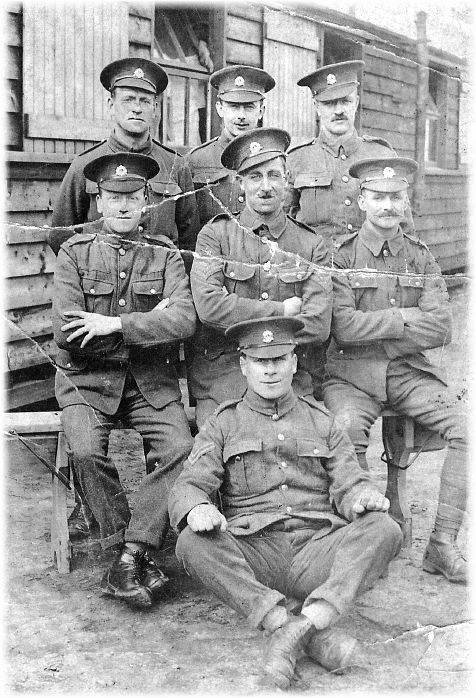
Private Brooks, top left.
In the spring of 1916 it was in action at the Bluff, south east of
Ypres on the Comines canal and then moved south to The Somme, seeing
action during The Battle of Albert (in which the Division captured
Fricourt) and The Battle of Delville Wood.
In 1917 the Division moved to Arras and saw action in The First and
Second Battles of the Scarpe and The Capture of Roeux. In late
summer it moved to Flanders and fought in The First and Second
Battles of Passchendaele.
In 1918 the Division was in action in The Battle of St Quentin, The
Battle of Bapaume, The Battle of Amiens, The Battle of Albert, The
Battle of Bapaume, The Battle of Havrincourt, The Battle of Epehy
and The Battle of Cambrai followed by The pursuit to the Selle, The
Battle of the Selle and The Battle of the Sambre. At the
Armistice (11th November) it was south east of Maubeuge and was
quickly withdrawn to the area west of Le Cateau. On the 6th of
December it moved back behind Amiens and went to billets around
Hallencourt. Demobilisation began in January 1919.
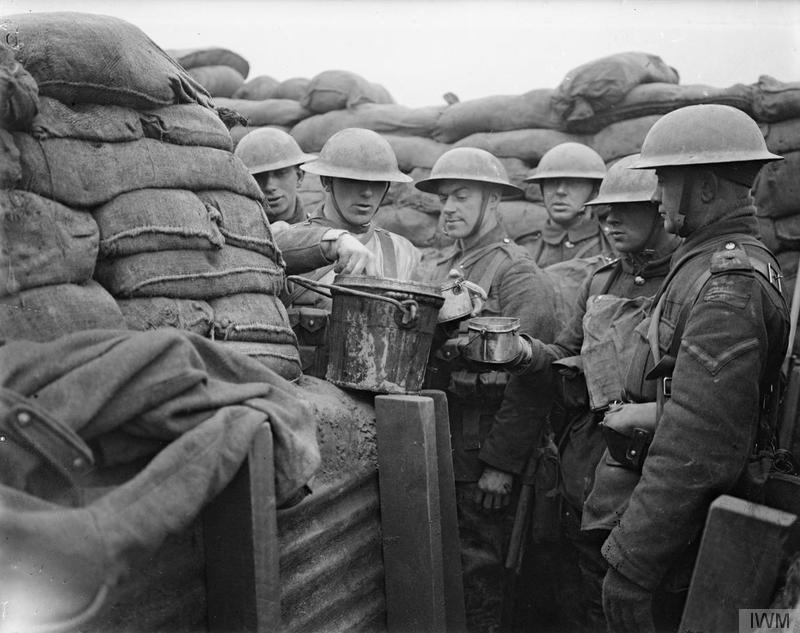
Serving hot stew to the troops of the
Lancashire Fusiliers in the front line trench from a container.
Opposite Messines, near Ploegsteert Wood, March 1917.
Judging from the date of his death and place of burial, Private
Brooks was probably killed in the action in the vicinity of the
French village of Neuvilly, on the
River Selle, during the Hundred Days Offensive. [Note]
The following extract, which described the 10th Battalion’s
activities on the day of Private Brooks’ death, is taken from
The History of the Lancashire Fusiliers 1914-1918, by
Major-General J. C. Latter C.B.E. M.C. (1949):
“For the first time for many months, troops
accustomed to the desolation of the Hindenburg Line saw untouched
fields and houses-and civilians who gave them the warmest possible
welcome. It was near the right of the British line that
battalions of the Regiment first became engaged during that month,
beginning with the 10th Battalion (Lieutenant-Colonel R.E. Cotton,
D.S.O.), which, after its fight near Gouzeaucourt, had a short
period of rest and training at Lesboeufs and Rocquigny before moving
forward again on 5th October to Equancourt. There, two days
later, it heard the official announcement that Germany had formally
approached the United States of America with a view to bringing
about a cessation of hostilities. On 8th October it moved
forward through Gonnelieu, past Villers Outreaux, Selvigny and
Montigny, to the sugar factory at Inchy, some three miles
west-north-west of Le Cateau, moving back a little a few hours later
to a position south-west of Inchy and digging in facing east.
There on the afternoon of 11th October it received orders to take
part on the following day in an attack at Neuvilly on the River
Selle, four thousand yards north-north-west of Le Cateau.
The brigade plan was that the 12th Manchester Regiment on the north
and the 9th Duke of Wellington’s Regiment on the south should cross
the bridges over the Selle at 5 a.m., make good the line of the
railway beyond it under cover of a creeping barrage, [Note]
and then establish themselves on the high ground north-east of the
village; ‘B’ Company of the 10th Lancashire Fusiliers behind the
Manchester and ‘A’ Company behind the Duke of Wellington’s were to
cross the river, ‘mop up’ the village from north and south
simultaneously and occupy a position north of the railway behind the
Manchester and be ready to support it if it was counter-attacked;
and the other two companies of the 10th were to be in reserve, ‘C’
on the right and ‘D’ on the left, at call if needed by ‘B’ or ‘A’.
At 1.15a.m. on 12th October the battalion began to move up to its
assembly positions west of the river, which it reached by 4 a.m.,
except for ‘A’ Company (Captain A. Wareham), which was delayed by
gas shelling. Our barrage came down at 5 a.m. and roused the
enemy to speedy retaliation, which resulted in Wareham being wounded
and replaced by Lieutenant W. Davidson, M.C., from battalion
headquarters. On the left the attack went well in spite of
stiff opposition, the Manchester crossing the river, storming the
high ground and beginning consolidation. ‘B’ Company (Captain
J. Knowles) of the l0th, following the Manchester, began to clear
Neuvilly village from north-west to south-east at 6 a .m., in the
face of strong resistance by a Jaeger regiment, which was supported
by many machine guns and cleverly posted snipers.
Second-Lieutenant S. W. Manning led his platoon with great gallantry
in this phase, capturing two parties of snipers, who were in a very
strong position in a house, by bombing them out. He was later
almost entirely responsible for the capture of some fifty prisoners,
including two officers, and for the killing of many snipers in the
village.
Things had not gone so well on the right, where the Duke of
Wellington’s had been unable to reach the top of the ridge, though
they had crossed the river and reached the railway. As their
rear platoons were still on the river, ‘A’ of the 10th was unable to
cross it and suffered considerable casualties from German machine
guns and snipers still on the south bank. ‘C’ Company
(Lieutenant R. Graham) therefore began at 5.48 a.m. to clear the
enemy from the eastern side of the village, meeting strong
opposition from houses and from a factory south-east of the cemetery
. . . .
In the meanwhile ‘B’ Company had practically cleared its share of
the village by 8.30 a.m., taking about thirty prisoners and killing
many Germans. Then, acting on the operation orders, it moved
up to the ridge in support of the Manchester. At about the
same time, ‘D’ Company (Captain F. W. Brittnell) was ordered to
reinforce that unit, which had become isolated owing to the
divisions on the flanks not being level with it, though two of its
platoons were detached to clear the cemetery into which some Germans
had returned from the railway. The enemy, indeed, throughout
the morning (perhaps enabled to do so by the bad visibility which
persisted throughout the day) had infiltrated parties back into the
village by way of a sunken road and a railway arch of such length as
to amount almost to a tunnel. By midday the enemy had in
effect reoccupied Neuvilly; so that at 12.50 p.m., ‘A’, part of ‘B’,
and ‘C’ Companies had to be ordered to clear it again, working from
north to south. ‘B’ Company met a large party of Germans at
the entrance to the village but scattered them with Lewis-gun fire.
[Note]
The enemy evidently attached great importance to the retention of
Neuvilly, for at 3 p.m. they put down a heavy barrage and
counter–attacked the 12th Manchester, who were driven back, with the
elements of ‘D’ and ‘B’ Companies of the 10th Lancashire Fusiliers
attached to them, to a position near the river. The Germans
succeeded in regaining the line of the railway and part of the
village, but were prevented from crossing the river by elements of
all four companies of the 10th which had taken up positions on its
bank. At 5 p.m. ‘A’ and ‘C’ Companies were once more sent to
clear the village south of the river; they found no Germans but were
much troubled by machine-gun fire from the north bank. When
darkness fell, the Manchester were established on the far bank of
the river, whose crossings were held by ‘C’, ‘B’, and ‘A’ companies
of the Lancashire Fusiliers, the whole battalion being relieved at 5
a.m. on 13th October and returning very tired to Inchy. Its
losses had been 5 officers and 182 other ranks; it had captured
2 officers, 58 other ranks and a number of machine guns, though many
were retaken by the enemy in their counter-attack.”
From the Parish Magazine, November 1918:
“George Brooks 10th Lancashire Fusiliers
was killed in France on October 12th. He joined the Army
September 1915 in the Bedfordshire Regt. In June 1916, he
crossed the channel. He was then transferred to the
Lancashire Fusiliers. In February of this year, he was badly
gassed and crippled with trench fever [a moderately
serious disease transmitted by body lice] and invalidated home.
He recovered and returned to the front in September last and took an
active part in the successful operations of the last two months.
His
Captain, writing to Mrs Brooks, says ‘Please accept my most sincere,
sympathy, in your bereavement, and may the knowledge, that your
husband died manfully fighting his best for King and Country,
comfort you, and give you some degree of solace in your sorrow.
He leaves behind him here the memory of one who ever did his duty
manfully.’“

Montay-Neuvilly Road Cemetery was made by the 23rd Brigade, Royal
Garrison Artillery, [Note] on the
26th and 27th October 1918. It contained originally 111
graves, mainly of officers and men of the 38th (Welsh) and 33rd
Divisions, and the 6th Dorsets, but after the Armistice it was
increased when graves were brought in from the battlefields west,
north and east of Montay, and from certain small cemeteries
including Neuvilly British Cemetery (No. 1), a little South-East of
the village, made by the 17th Division which contained the
graves of 22 soldiers from the United Kingdom who fell on the 12th
October 1918.
There are now 470 Commonwealth burials and commemorations of the
First World War in this cemetery. 61 of the burials are
unidentified but there is a special memorial to one casualty
believed to be buried among them. All fell in the period
October or November 1918. There is also a plot of 27 German
graves within the cemetery.
――――♦――――
ANDREW CRANSTON BROWN
Second Lieutenant, “C” Coy. 8th South Staffordshire Regiment.
Son of Katherine of Springfield, Downton, Salisbury, and the late
James Brown of Harvieston, Tring.
Killed in action on 2nd July 1916, aged 21.
Buried in the Dantzig Alley British Cemetery, France, grave ref. V.N.9.
Lieut. Brown is also commemorated on the memorial stone of his
father,
Dr James Brown, in Tring Cemetery.
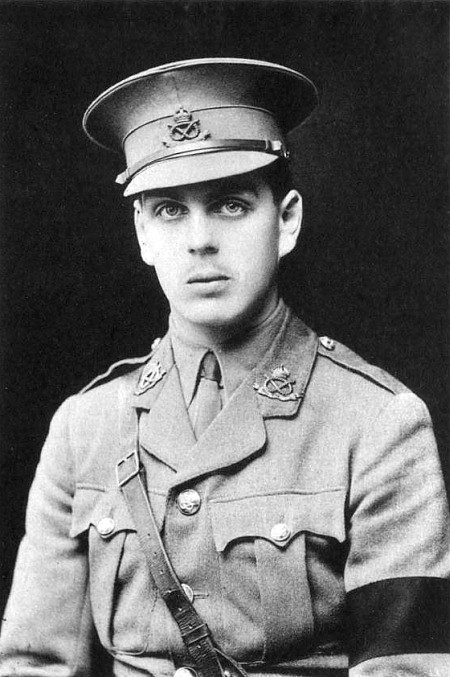
The 8th (Service) Battalion, South Staffordshire Regiment, was
raised at Lichfield in September 1914 as part of Kitchener’s Second
New Army [Note] and joined the 51st Brigade, 17th (Northern) Division.
After initial training close to home, they moved to Wareham, Dorset,
to continue training, then moving to West Lulworth and to Wool in
January 1915. In June 1915 they moved to the Winchester area.
The division had been selected for Home Defence duties, but this was
reversed and they proceeded to France in July 1915, concentrating
near St Omer. They then moved into the Southern Ypres salient for
trench familiarisation before taking over the front lines in
that area.
In the spring of 1916, the Division was in action at the
Bluff, south east of Ypres on the Comines canal. It then moved south to
The Somme where it was in action during The Battle of Albert in which
its troops captured Fricourt, which formed a salient in the German
front-line and was the principal German fortified village between
the River Somme and the Ancre. Lieut. Brown fell during this
action, which occurred on the second day of the Anglo-French offensive operations
known as The Battle of the
Somme (1916). [Note]
The Allied preparatory artillery bombardment [Note] commenced
on 24th June and the Anglo-French infantry attacked on 1st July on
the south bank, from Foucaucourt to the Somme, and from the Somme
north to Gommecourt, 2 miles beyond Serre. The French Sixth
army and the right wing of the British Fourth Army inflicted a
considerable defeat on the German 2nd Army, but from the Albert–Bapaume
road to Gommecourt the British attack was a disaster, and it was
here that many of
the estimated 60,000 British casualties on the first day of the
Battle occurred.
In his History of the Great War – The British Campaign in France
and Flanders, Sir Arthur Conan-Doyle describes the action at
Fricourt on July 2nd, in which the 8th South Staffs Battalion (51st
Brigade) was involved:
. . . . the 51st Brigade passed
through the deserted village of Fricourt upon the morning of July 2,
taking about 100 prisoners.
On debouching at the eastern end they swung to the right, the 7th
Lincolns attacking Fricourt Wood, and the 8th South Staffords,
Fricourt Farm. The wood proved to be a tangle of smashed
trees, which was hardly penetrable, and a heavy fire stopped the
Lincolns. The colonel, however, surmounted the difficulty by
detaching an officer and a party of men to outflank the wood, which
had the effect of driving out the Germans. The South Staffords
were also successful in storming the farm, but could not for the
moment get farther. Several hundreds of [German]
prisoners from the 111th Regiment and three guns were captured
during this advance, but the men were very exhausted at the end of
it, having been three nights without rest.
Early next day (July 3) the advance was
resumed, the 51st Brigade still to the fore, working in
co-operation with the 62nd Brigade of the Twenty-first Division upon
their left. By hard fighting, the Staffords, Lincolns, and
Sherwoods pushed their way into Railway Alley and Railway Copse,
while the 7th Borders established themselves in Bottom Wood.
The operations came to a climax when in the afternoon a battalion of
the 186th Prussian Regiment, nearly 600 strong, was caught between
the two Brigades in Crucifix Trench and had to surrender; altogether
the 51st Brigade had done a very strenuous and successful
spell of duty. The ground gained was consolidated by the 77th
Field Company, Royal Engineers.
The following is an extract from the 8th Staffordshire Battalion
War Diary covering the date on which Lieut. Brown was killed.
In places I have had to mark the text unclear [???] where I have
guessed a word, or illegible [###] where I could not:
1916
MORLAN-COURT
July 1st: 12-35am. Bn. arrived in billets.
Reveille & breakfast at 4.45am. At 5.30am stores and bombs
[???] tools etc were drawn from
dump. Packs all stored [???]
& Regt. ready to move at a moment’s notice. At 7.30am assault
was commenced by troops in front line. Prisoners commenced to
arrive. Sudden [???]
orders received at 8pm to move to MEAULTE. On arrival, orders
received to proceed to 50th Bde [???]
forward dump in vicinity of BECORDEL BECOURT where new instructions
were issued that Bn. was to relieve [###]
7th [???] East Yorks in the
trenches.
TRENCHES FRICOURT
July 2nd: Relief commenced at 3am and completed by
5.30am. Many wounded lying outside our trenches, the attack by
the 50th having failed. Stretcher bearers collected wounded &
as they were not fired on an investigation of trenches in front
undertaken by patrols. Germans hiding in trenches immediately
began to surrender & about 110 were taken & sent down to Bdg. HQ.
Major R. G. Raper organized parties to bomb remaining dug-outs.
11am: Orders received to attack Fricourt.
12.15am [pm???] Advance
commenced. Fricourt Village captured without opposition.
2nd objective viz. edge of Fricourt Wood taken under MG fire.
At 12.40 [???] attack by B & C
Coys launched on 3rd Objective, viz. LOZENGE ALLEY under supervision
of Major Raper. Strong rifle and MG fire met with but trench
carried. Major Raper killed. Lt. Curtis & Lloyd wounded.
2nd Lieut. Brown killed. Impossible to advance
[###] in there [???]
as Lincoln Regt on the right [???]
has not kept pace & has not yet occupied northern edge of Fricourt
Wood.
Throughout the day, Lieut. W. TURNEY had gallantly led battle
patrols which located the enemy in various trenches. At 12
noon the Lincolns still having failed to take Railway Alley which is
a continuation of Lozenge trench already occupied by the 8th S.
Staffords, the Sherwood Foresters made an attempt without much
success.
3rd July: At 11.30 am by a simultaneous assault, the
S. Staffords, Sherwoods & Lincolns carried Railway Alley, Crucifix
Trench & trenches beyond [to]
take the whole of the 186th R.I.R. (Prussian) [186th
Prussian Regiment] prisoner. Numbers
about 20 officers & 700 other ranks. Position consolidated. At
6pm orders received to consolidate a new line 1200 yards further
forward. Bn. reached this new line (later known a Hefe
[???] trench) after dark and dug in
all night. One Coy. of prisoners [???]
assisted.
From the Bucks Herald, 15th July 1916:
“Death of Lieut Andrew Brown. – News has
reached Tring that Second Lieut Andrew C. Brown, South Staffs Regt.
was killed in action on July 2nd. Lieut Brown, who was not
quite 22, was the only son of the late Dr James Brown and Mrs Brown
of Harveston. The news created a painful sensation in the town
where Lieut Brown was so well known and called forth from all
classes expressions of the sincerest sympathy with Mrs Brown in
this, her second great bereavement.”
From Memorials of Rugbeians [Rugby School] who fell
in the Great War (Volume III) by W. N. Wilson:
SECOND LIEUTENANT A. C. BROWN
11th (RESERVE) BATTALION THE SOUTH STAFFORDSHIRE REGIMENT
ANDREW CRANSTON BROWN
was the only son of James Brown, M.B., and of Katharine his wife, of
Harvieston, Tring. He entered the School in 1903, left in
1911, and went to Queen’s College, Oxford, in I913, in order to
qualify for his father's profession. Directly War was declared he
enlisted as a private, but obtained a Commission in the South
Staffordshire Regiment in September, 1914. He went to France in
March, 1916, attached to the 8th Battalion of his Regiment.
He took part in the Battle of the Somme, and on the second day was
killed in action, in the foremost line of the advance, at Fricourt,
on July 2nd, 1916. Age 21.
His Colonel wrote:— “He was killed in a very gallant attack that he
and his men were making on German trenches, north of Fricourt. He
appears to have taken a trench, and then to have been engaged on
clearing it to the right. It may please you to know that your boy's
Regiment, in which he had so many friends, and in which he had
always done such splendid work, has done magnificently from the
moment it went over the parapet.”
And his Captain wrote :— “I was in command of C Company, and all the
time your son was with me l found him one of the most fearless and
utterly reliable Officers I have ever met. He was one of the most
popular men in the Regiment, and his men were ready to follow him
anywhere. I shall always remember him as one of my best friends, and
for the noble, fearless way in which he fought and met his death.”
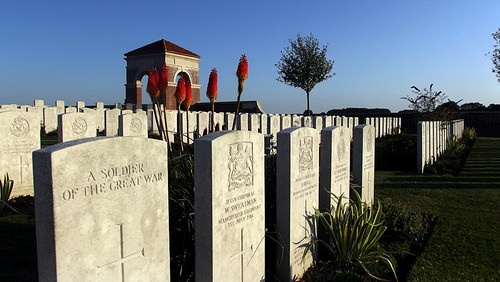
Dantzig Alley British Cemetery: the village of Mametz was carried by
the 7th Division on the 1st July 1916, the first day of the Battle of the
Somme, after very hard fighting at Dantzig Alley (a German trench)
and other points. The cemetery was begun later in the same
month and was used by field ambulances and fighting units until the
following November. The ground was lost during the great
German advance in March 1918 but regained in August, and a few
graves were added to the cemetery in August and September 1918.
At the Armistice, the cemetery consisted of 183 graves, now in Plot
I, but it was then very greatly increased by graves (almost all of
1916) brought in from the battlefields north and east of Mametz and
from certain smaller burial grounds.
____________________
Whilst gathering material on the fate of Lieut. Brown, I discovered
that something had been written about his colleague, Major R. G.
Raper, who was also killed in action at Fricourt on July 2nd (see
War Diary above). It is worth repeating here:
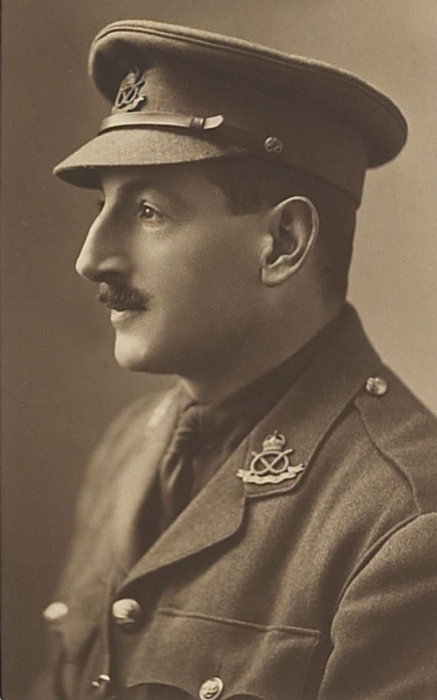
Major R. G. Raper, South Staffordshire
Regiment.
Killed in action at Fricourt, July 2nd, 1916, aged 39.
“The Brigade was then moved to Armentieres,
from March 16th to June 14th, where they had a comparatively quiet
time. From there they went to Albert, and on July 2nd, on the
second day of what one of the Staff Officers of the Brigade, writing
on the 6th about Major Raper’s death, described as ‘probably the
biggest battle in the history of the world,’ they attacked and
captured Fricourt. The battle so described is officially
termed ‘The Battles of the Somme, 1916,’ of which ‘The Battle of
Albert,’ July 1st to 13th, was the first. As the Commanding
Officer stated, Major Raper ‘was gallantly superintending an
operation by two companies and had just succeeded in carrying out
his object, when a machine gun swept the whole front and he was
killed instantaneously. Earlier in the day,’ he added, ‘I had
occasion to notice several pieces of excellent work that he did, and
I intend sending in his name to the higher authorities.’ Major
Raper was mentioned in Sir Douglas Haig’s Despatch dated November
13th, 1916. His old Commanding Officer, then in command of
another Brigade, said :— ‘I always looked on him as a man of the
highest character and principles, absolutely brave himself and
inspiring courage in others. It win indeed be hard to replace
him in the Regiment.”
――――♦――――
FRANK BURCH, M.M.
Private, 1st Bedfordshire Regiment, service no. 266610.
Son of John and Emily of 25 The Front, Potten End.
Killed in action in France on 27th September 1918, aged 24.
Buried in Villers Hill British Cemetery, France, grave ref. VI. B. 24.
Private Burch was attached to the 1st Battalion, Bedfordshire
Regiment. At the outbreak of war this ‘Regular Army’ battalion
was based at Mullingar in Ireland. On mobilisation it left
Ireland as part of 15th Infantry Brigade in the 5th Division,
[Note] landing in France on
the 16th August 1914. Excluding a brief deployment to Italy
(December 1917-April 1918) to strengthen the Italian resistance
after a recent disaster at the Battle of Caporetto – the Battalion
fought in France and Belgium for the remainder of the war where it
took part in most of the major actions.
Having stemmed the 1918 German Spring Offensive, [Note]
the Allies went on the offensives in what became known as the “100
Days Offensive”. [Note]
During this period 1st Bedfordshire Regiment was engaged in several actions – the Battle of
Albert in August, and the Second Battle of Bapaume in
August/September, the Battle of the Canal du Nord in September
(during the Battles for the Hindenburg Line), the Battle of the
Selle in October during the Final Advance in Picardy in
October/November.
The Parish Magazine does not identify the action in which
Private Burch lost his life, but regimental records record that in
September 1918 the 1st Battalion was
engaged in the Battle of Canal du Nord, part of a Allied offensive
against German positions on the Western Front [Note]
during the final period of the First World War. The battle took place between
27th September − the day on which Private Burch was killed − and 1st
October 1918 along an incomplete portion of the Canal du Nord on the
outskirts of Cambrai. To avoid the risk of extensive German
reserves being massed against a single Allied attack, the assault
along the Canal du Nord was undertaken as part of a number of
closely sequenced Allied attacks at separate points along the
Western Front.
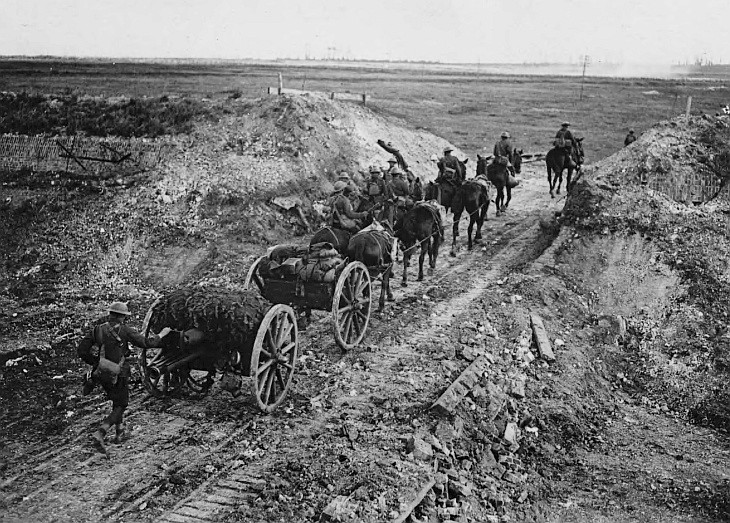
|
Some horse-drawn artillery
wagons entering a cutting in the Canal du Nord, 1918.
The Canal du Nord, which was
being built when war broke out in August 1914. Its
excavations made a perfect defensive system, and the
Germans incorporated the ‘canal’ into their famous
Hindenburg Line. Still further, the marshy terrain
on both sides of the Arras to Cambrai road combined with
the elevated German defences, made it a very difficult
position to attack. |
On the morning of 27th September the Canal was attacked in total
darkness. The German defenders were completely surprised and
either retreated or were captured. The attack penetrated a
majority of the defences of the Hindenburg Line [Note] and allowed the next
attack (the Battle of Cambrai, 1918) to complete the penetration and
begin the advance beyond the Hindenburg Line. Meanwhile, on
the 15th September 1918, the 1st Bedfordshires were billeted in huts
and dug-outs in VILLERS-au-Flos, a small village in the North-East
of France, with “Enemy aircraft very active bombing vicinity of
village at night.” The Battalion War Diary
continues the story:
22nd Sep: In Camp as above.
Church services for all denominations. H.V. Guns again active.
2/Lt R. J. CROPLEY severely wounded & died later in the day.
23rd Sep: As above, frequent enemy shelling around
Camp.
24th Sep: As above.
25th Sep: As above. Bde O.O. received for relief on
following day. Battalion to remain in same camp.
26th Sep: Battalion received orders to move up to
assembly positions ready for forthcoming operations.
[The Battle of the Canal du Nord]
27th Sep: Beaucamp.
Battalion advanced over the top to the attack at 7.52 am & captured
part of Beaucamp Village all objectives taken. During the
afternoon German Bombing Party attacked which caused Battalion to
draw back to Sunken Road & evacuate the village. Capt H. C.
LOE, M.C. & 2/Lt. H. HUTCHINSON killed. Capt. R.L. Shaw, Capt
& Adjt. A. H. O. RIDDELL, Lt. F. H. MELVILL & 2/Lts. W. T. MORRIS,
J. T. LAUGHTON, [died on the Ambulance train that day],
G. W. BLACKWELL wounded. Other Ranks - 19 Killed, 96
Wounded, 1 Died of Wds, 19 Missing & 1 Wd. & Missing.
28th Sep: Germans evacuated BEAUCAMP. Cheshires
& Norfolks advanced with Bedfords & Warwicks in support. Lt.
C. G.WILKINS, Wd. at duty. O.R. - 1 Killed & 3 Wounded.
29th Sep: Bedfords passed through 95th Bde & attacked
beyond railway & consolidated. 2/Lt. W. B. J. BRANDRETH Wd. 2/Lt. F.
WHATELY-KNIGHT Wd. at duty. O. R. - 1 Killed, 2 Died of Wds, 3
Wounded, 1 Missing.
30th Sep: Dead Man’s Corner Germans retiring,
Battalion moved forward. Relieved in evening by 13 K.R.Rs.
37th Division & withdrew to Dead Mans Corner. 5 O.R. Wounded 2
Died of Wounds.
Private Burch was born in Tring and lived in Aldbury. This from
The Parish Magazine, 1919:
“We have just received a letter from a
Captain concerning the death of Frank Burch M.M. ‘I should have
written before, only I was rather badly wounded by the same shell
which killed your son. He was orderly, and a very good boy
indeed. He was also a very gallant soldier and had twice been
recommended for the Military Medal, without having the luck to get
it. You will be glad to know that he did not suffer any pain
what so ever. He and I were laughing and talking together when
a big shell came and dropped at my feet. It was a big shock
and when the smoke cleared away and I came to my senses I saw that
your son had been struck on the head and killed instantly. It
was a miracle that I escaped with my life, for, although I was hit
by over 30 pieces of shell, there were none of them in a vital spot.
Your son was well liked by the officers and men of the company.
I shall always remember him as a fine young Englishman and gallant
comrade.’”
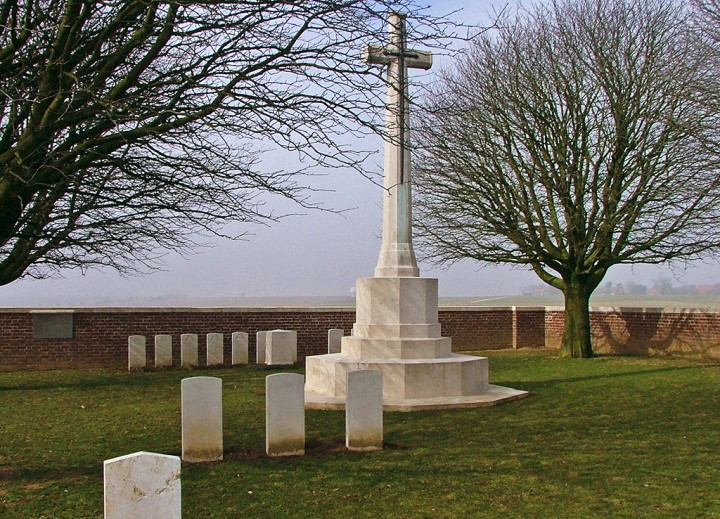
Villers Hill British Cemetery.
Villers-Guislain was occupied by Commonwealth forces from April 1917
until the German counter attacks at the
end of November 1917 in the Battle of Cambrai. It was lost on 30th November and
retained by the Germans on 1st December in spite of the fierce
attacks of the Guards Division and tanks. The village was
finally abandoned by the Germans on 30th September 1918 after heavy
fighting.
The Villers Hill British Cemetery now contains 732 Commonwealth
burials and commemorations of the First World War. 350 of the
burials are unidentified but there are special memorials to seven
casualties known or believed to be buried among them. Other
special memorials commemorate casualties buried in Gonnelieu
Communal Cemetery and Honnecourt German Cemetery whose grave could
not be found. The cemetery also contains 13 German burials.
――――♦――――
THOMAS CARTWRIGHT
Private, 78th Battalion Canadian Infantry (Manitoba Regiment)
service no. 147356.
Son of Susan of 354 Union Avenue, Elmwood, Manitoba, Canada and the
late John Cartwright.
Killed in action on 19th November 1916, aged 25.
No known grave. Commemorated on the Vimy Memorial, France.
Private Cartwright was born in Tring. As a boy he was a member
of the Parish Church Choir and the Church Lads’ Brigade.
Before the War, along with other Tring lads, he probably took
advantage of Lord Rothschild’s assisted emigration scheme to settle
in Canada. Early in his life in the west he joined the
Manitoba volunteers, and it was while fighting with that force that
he lost his life. Writing to his mother, his officer said “Tommy,
as we called him, was the friend of all in the regiment − so
dependable, always so willing, and such a true sportsman.”
He was also a loyal churchman and took a keen interest in the work
of St Johns, Winnipeg.
The 78th Battalion was an infantry battalion of the Canadian
Expeditionary Force. It was recruited in Winnipeg and the
surrounding area and fought in France and Flanders until the
armistice as part of the 12th Brigade, 4th Canadian Division.
At the time Private Cartwright was killed, the 4th Division was
engaged in the Battle of Ancre (13th-19th November, 1916).
This final phase of the first battle of the Somme involved an attack
on the German front line as it crossed the Ancre River, its core
objective being to eliminate a German salient between the Albert-Bapaume
road and Serre, with Beaumont-Hamel at its head. The attackers
had to contend with deep mud, heavy enemy fire and poor visibility.
They failed to achieve the battle’s main objectives, although in the
marshy lowlands near the river some gains were made, but at great
cost. On 19th November, with winter rain enshrouding the
battlefield, offensive operations were called off.
Extracts from the 78th Battalion War Diary for the period
covering Private Cartwright’s death follow. During this
time the troops were at — 5th November, Bouzincourt; 16th Nov, at
TARA HILL; 17th Nov, in SUGAR/FABECK TRENCH; 18th Nov, in front line
with support in REGINA TRENCH; 19th Nov, in front line with support
in REGINA TRENCH, reserve in VANCOUVER TRENCH; 20th Nov, in front
line, with support in REGINA TRENCH, reserve in VANCOUVER TRENCH;
21st D Coy in front line equipped with “thigh rubber boots”;
22nd relieved in front line; 23rd at ALBERT. It is rare to
find “Other Ranks” killed in action being named individually in
War Diaries — officers generally are — so one must assume the
soldier being sought is among the “casualties”: |
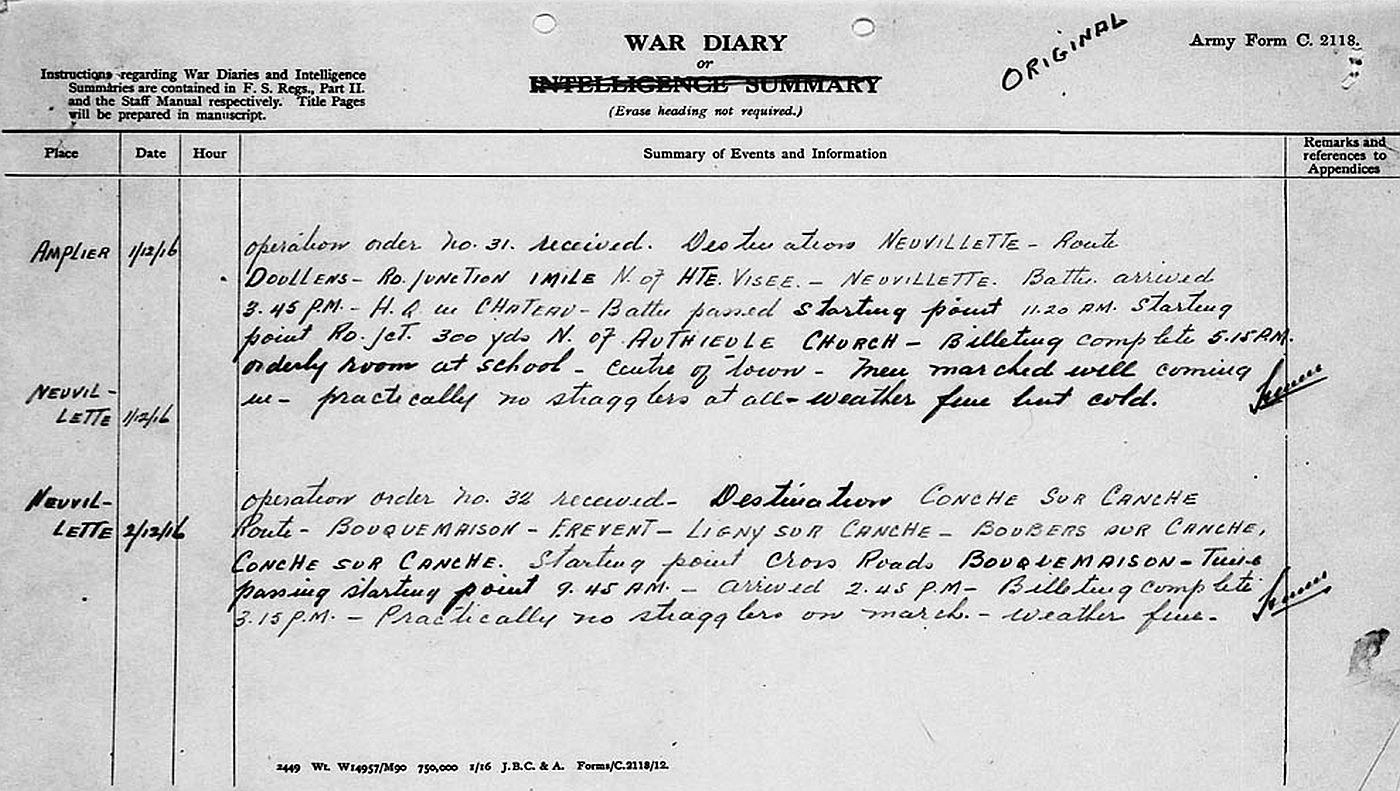
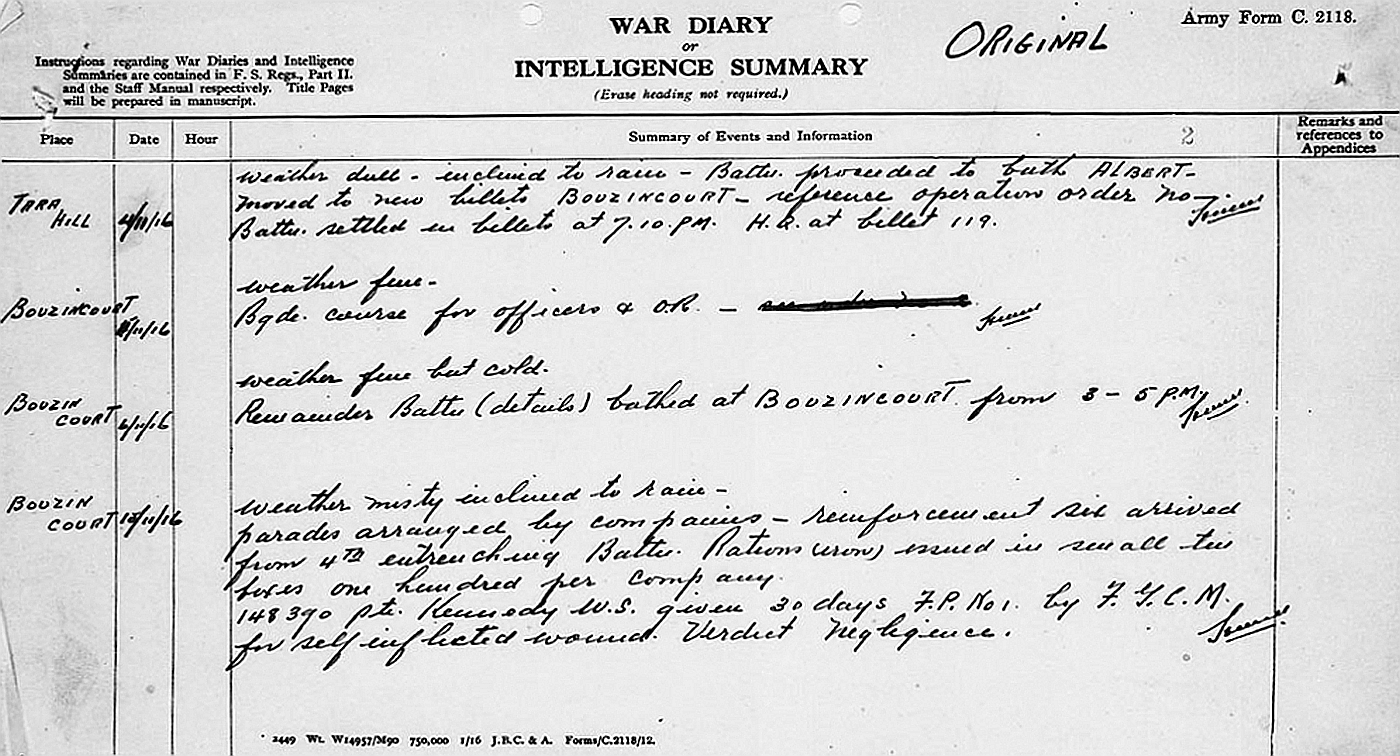
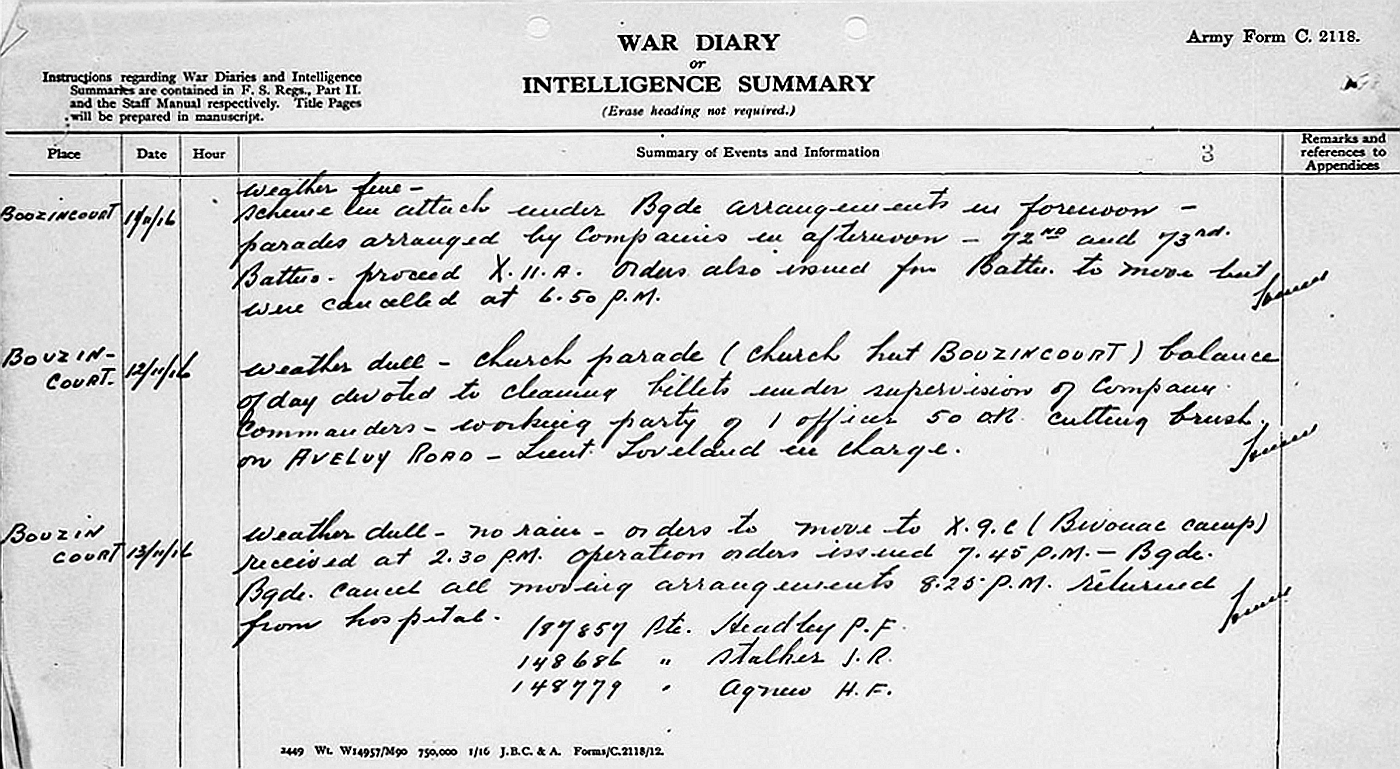
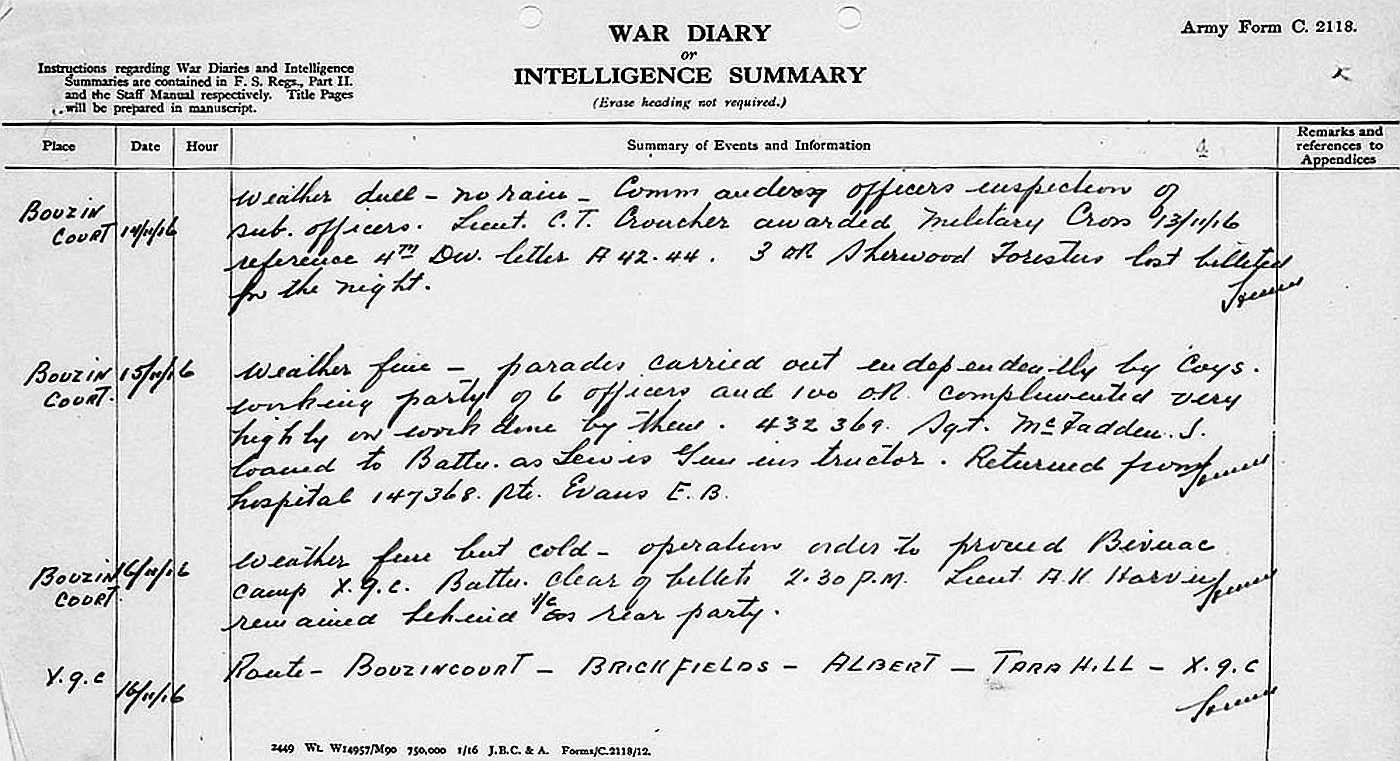
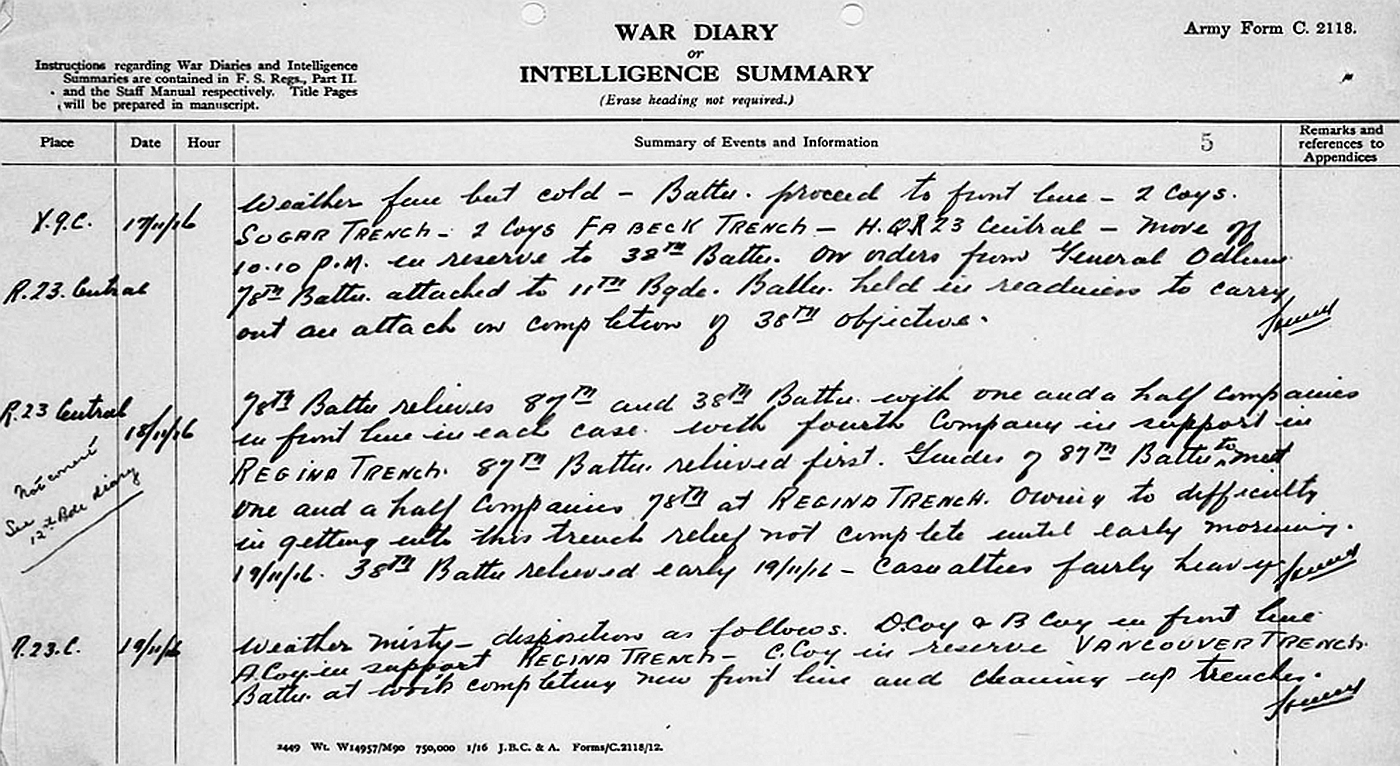
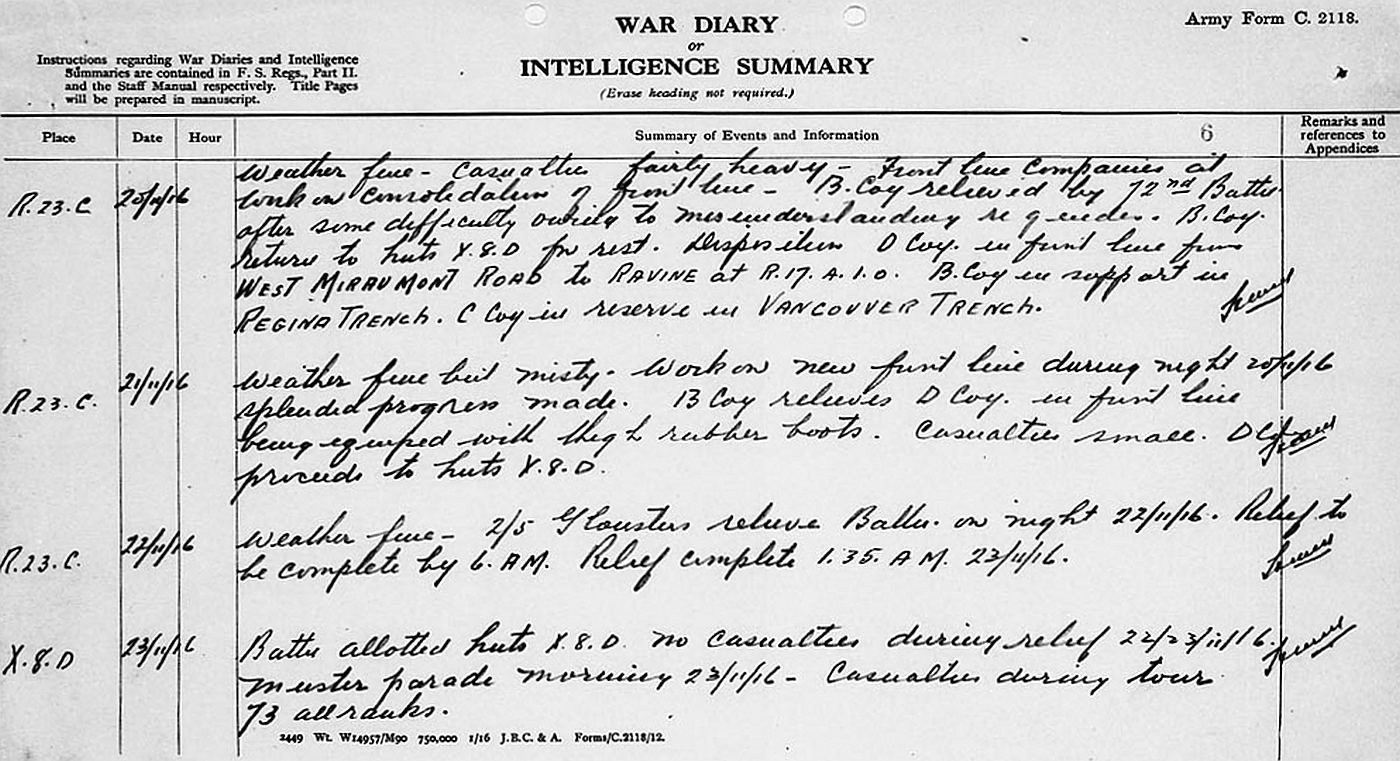
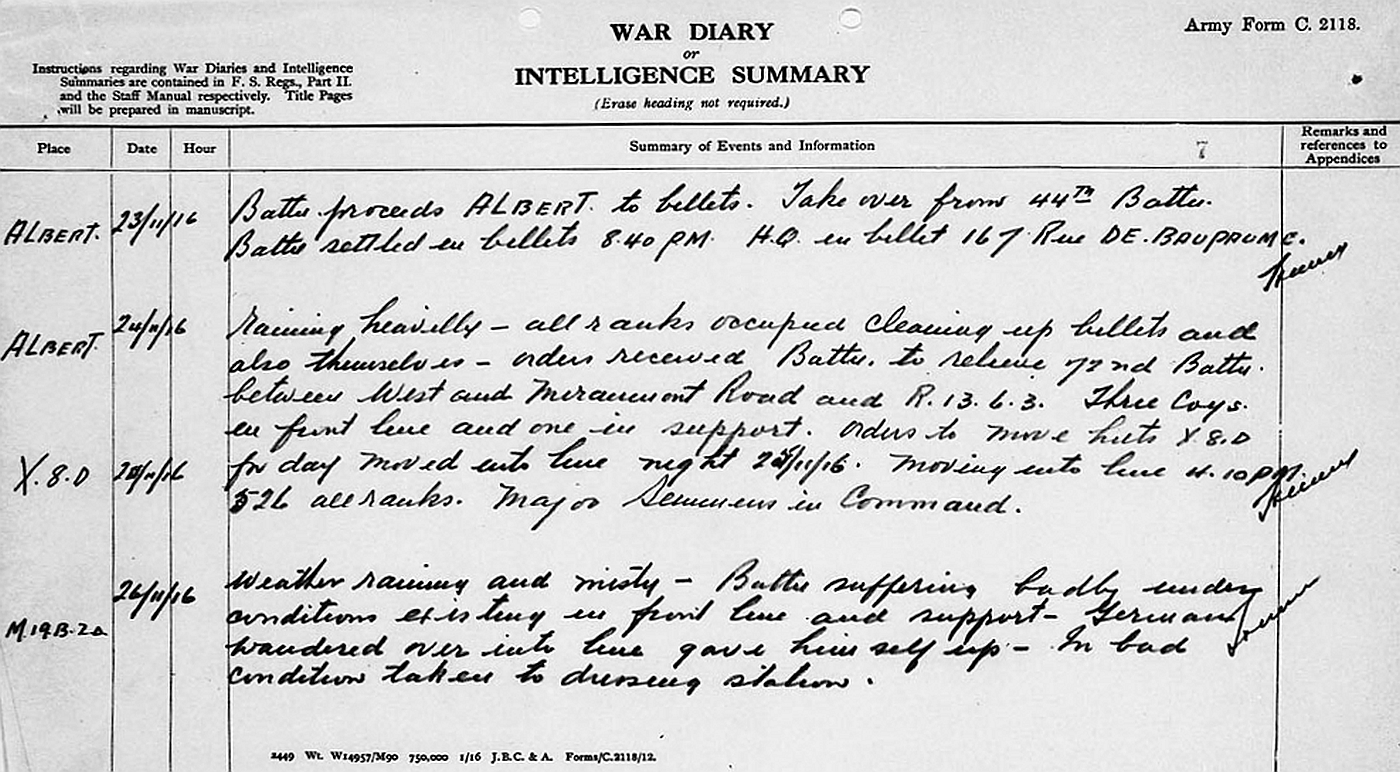

The Canadian National Vimy Memorial.
The Battle of Vimy Ridge (9th–12th April 1917) was the first
occasion on which the four divisions of the Canadian Expeditionary
Force participated in a battle as a cohesive formation. Their
objective was to take control of the German-held high ground along
an escarpment at the northernmost end of the Arras Offensive.
By nightfall on 12th April 1917 the Canadian Corps was in firm
control of the ridge, but at the cost of 10,602 casualties: 3,598
killed and 7,004 wounded. After the War, France ceded to
Canada perpetual use of a 250-acre portion of the former Vimy Ridge
battleground on the understanding it was used to establish a
battlefield park and memorial. This land now serves as the
site of the Canadian National Vimy Memorial for Canadian soldiers of
the First World War, killed or presumed dead in France, who have no
known grave. Wartime tunnels, trenches, craters, and
unexploded munitions still honeycomb the site, which remains largely
closed off for reasons of public safety.
――――♦――――
REGINALD ROBERT CATO
Gunner, 31st Siege Battery Royal Garrison Artillery, [Note] service no.
63521.
Husband of Florence May Harris (formerly Cato), of 22 Akeman Street,
Tring.
Killed in action on the 10th March 1918 aged 35.
Buried in the Ypres Reservoir Cemetery, Belgium, grave ref. III. C. 25.
Headstone inscription AT REST
SIEGE BATTERIES: with the new long-range small arms available to the
infantry in the era before the First World War, artillery fighting
with the infantry was increasingly brought under fire. Thus
developed the principle in which the artillery was positioned well
behind the infantry battle line, firing at unseen targets using map
co-ordinates calculated with geometry and mathematics. As the
war progressed, these long-range heavy artillery techniques were
massively developed.
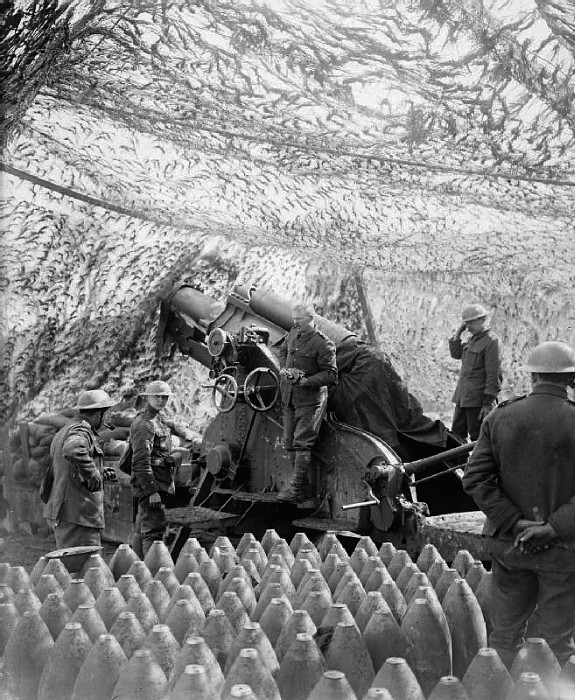
|
Royal Garrison Artillery 9.2” Howitzer of 91st
Battery, Royal Garrison Artillery in position under
camouflage netting in readiness for the opening barrage
of Arras, 1 April 1917. |
Siege batteries, such as that Gunner Cato was attached to, were
usually armed with 6 inch, 8 inch and 9.2 inch howitzers − there
were also huge railway and road-mounted 12 inch howitzers − that
fired large calibre high explosive shells in high trajectory onto
the enemy’s strong-points, supply/ammunition dumps, stores, roads
and railways that lay well behind their lines. They also
attempted to destroy or neutralise opposing enemy artillery (a
tactic known as “counter-battery fire”) that had been located from
the air by kite balloons or aircraft − it is possible that Gunner
Cato was killed during such an exchange, but in the absence of a
War Diary for 31st Siege Battery in 1918, nothing definite can be
established.
From the Bucks Herald, 23rd March 1918:
“ROLL OF HONOUR.−
News has been received by Mrs. Cato, of 22 Akeman Street, that her
husband, Gunner Reginald R. Cato, 31st Siege Battery, R.G.A., has
been killed in France. Writing on March 10, the Officer
Commanding the Battery conveyed the sad news that Gunner Cato was
killed in action, his death being instantaneous, and his loss was
keenly felt by both officers and men. Before joining the Army
and 2½ years ago, Cato was employed by Mr. H. C. Cook, builder and
contractor, and was held in high esteem as a steady and
conscientious worker. He had been in France for some two
years, and with his battery had taken part in some of the heaviest
fighting. He leaves a widow and three young children, for whom
the deepest sympathy is felt in their sad bereavement. He was
a native of Tring and 32 years of age.”
His Captain writes:
“I am most grieved to have to inform you
that your husband has been killed in action. I feel quite
certain that his death was instantaneous. He was not in anyway
disfigured. I cannot express to you how deeply we sympathise
with you in your bereavement. I hope it will be of some
consolation to you to know we all share your loss with you, and that
when any man such as your husband is killed, it leaves a gap that we
all feel. Your husband was a good steady hard working man, who
never fell short of that standard. He will be greatly missed
by the whole battery.”
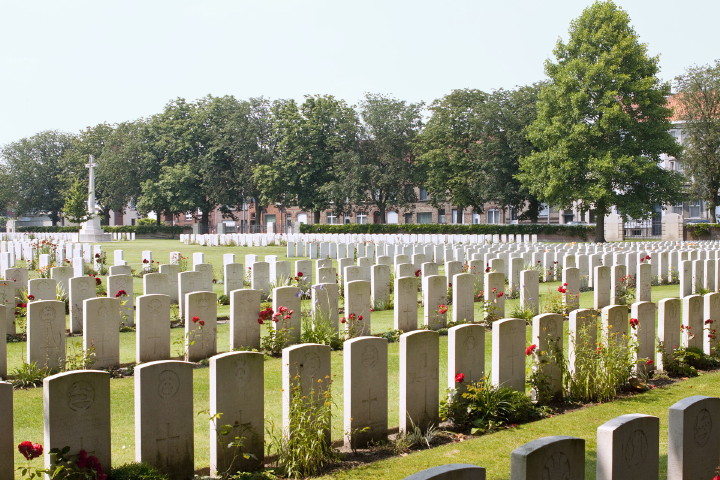
Ypres Reservoir Cemetery, where Gunner Cato is buried, was begun in
October 1915 and used by fighting units and field ambulances until
after the Armistice by which time it contained 1,099 graves.
The cemetery was later enlarged when graves were brought in from the
battlefields of the salient and the following smaller burial
grounds.
――――♦――――
FREDERICK EDWARD CLARKE
Private, the East Surrey Regiment.
Only son of Mr. and Mrs. Frank Clarke, Ashburnham Villas, Western
Road, Tring.
Wounded on 4th October 1917 in the Battles for Paschendale Ridge and
evacuated back to England.
Died of Pnumonia on 7th November 1918 at Horton Hospital, Epsom,
Surrey, aged 20.
Buried in Tring Urban District Cemetery, grave ref. plot 1, grave
193.
Born at Stratford, Essex. Formerly a member of Tring Town
Band. Enlisted at Watford.
Private Clarke was wounded during the Third Battle of Ypres (31st
July–10th November 1917). Now generally known as Passchendaele,
this offensive was an Allied attempt to break out of the confines of
the salient of trenches around Ypres. It began with
encouraging Allied gains, but heavy rain soon bogged it down and by
August it was clearly failing with an enormous cost in casualties to
both sides (325,000 Allied; 260,000 German). Continuing bad
weather in October led to the battlefield becoming an impassable
quagmire, with further attacks failing to make much progress.
Eventually the capture by Canadian forces of what little remained of
Passchendaele village gave General Haig [Note] an excuse to call off the
offensive and claim success. Wartime Prime Minister David
Lloyd George expressed the view that “Passchendaele was indeed
one of the greatest disasters of the war . . . . No soldier of any
intelligence now defends this senseless campaign . . . .”
From the Bucks Herald, 16th November 1918:
“Pte. Frederick Edward Clarke, only son of
Mr. and Mrs. Frank Clarke, Ashburnham Villas, was in the 5th
Battalion East Surry Regiment, and was wounded in France in October
of last year. Since then he has been in England suffering from
septic pneumonia after operation. He recovered from this, but
a subsequent attack proved fatal, and he died in Horton Military
Hospital on Nov. 7. Pte. Clarke was 20 years of age. His
remains were interred at Tring Cemetery on
Wednesday afternoon, the last rites being performed by the Rev. S.
E. Garrard.”
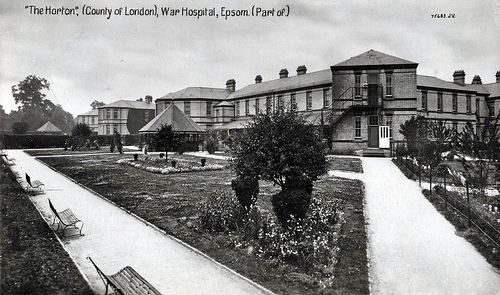
Horton Hospital (formerly Horton Asylum) was opened in 1902.
It was a large psychiatric hospital in Epsom designed for the London
County Council by George Thomas Hine, consultant architect to the
Commissioners in Lunacy to the London County Council. During
both World Wars Horton was commandeered as a military hospital and
the existing patients transferred elsewhere. It closed in 1997
and was later sold for redevelopment.
――――♦――――
JAMES CLEMENTS
Gunner, 423rd Battery, 264th Brigade, Royal Field Artillery, service
no. 154185.
Died of fever on the 23rd November 1918.
Buried in Beirut War Cemetery, Lebanon, grave ref. 282.
During the war the port city of Beirut suffered a blockade by the
Allies, intended to starve out the Turks. This, combined with
a series of natural disasters, resulted in widespread famine,
followed by plague, which killed more than a quarter of the
population. The city fell on 8 October 1918 and James died of
23 November 1918, possibly of wounds, possibly of disease in the
unhealthy city. He was buried in Beirut War Cemetery.
Born in 1890 in Wheatley, James was the son of Richard Clements,
farm labourer and cattleman, and Mary Hayfield, both of them also
born in the village, in 1864/65. In 1891 the family were
living on Farm Close Lane, and by 1901 at Ivy Hill Cottages, Holton.
James had attended Wheatley Elementary school and gone on to be a
labourer with threshing machine in 1911, living as a single man on
High Street. He married Kate Lee at Tring in Hertfordshire in
1915.
Gunner Clements served with the Royal Field Artillery (RFA) [Note] of the
British Army. The largest arm of the artillery, the RFA
provided close artillery support for the infantry. Organised
into brigades attached to divisions or higher formations, it was
responsible for the medium calibre guns and howitzers deployed close
to the front line.

An RFA 18-pounder and its gun crew.
The 18-pounder shown above was the standard British field gun of the
First World War era and as such formed the backbone of the RFA.
Produced in large numbers it was generally horse drawn and
reasonably mobile.
The following extract from Wheatley in a World at War 1914-19
(published by the Wheatley branch of the Royal British Legion in
2014) is the only reference I can find to Gunner Clements:
JAMES CLEMENTS,
ROYAL FIELD ARTILLERY
“154185 Gunner James Clements served with Royal Field Artillery.
During the war the port city of Beirut suffered a blockade by the
Allies, intended to starve out the Turks. This, combined with
a series of natural disasters, resulted in widespread famine,
followed by plague, which killed more than a quarter of the
population. The city fell on 8 October 1918 and James died on
23 November 1918, possibly of wounds, possibly of disease in the
unhealthy city. He was buried in Beirut War Cemetery (ref.
282).
Born in 1890 in Wheatley, James was a son of Richard Clements, farm
labourer and cattleman, and Mary Hayfield, both of them also born in
the village, in 1864/5. In 1891 the family were living on Farm
Close Lane, and by 1901 at Ivy Hill Cottages, Holton. He had
attended Wheatley Elementary school and gone on to be a labourer
with threshing machine in 1911, living as a single man on High
Street. James married Kate Lee at Tring in Hertfordshire in
1915.”
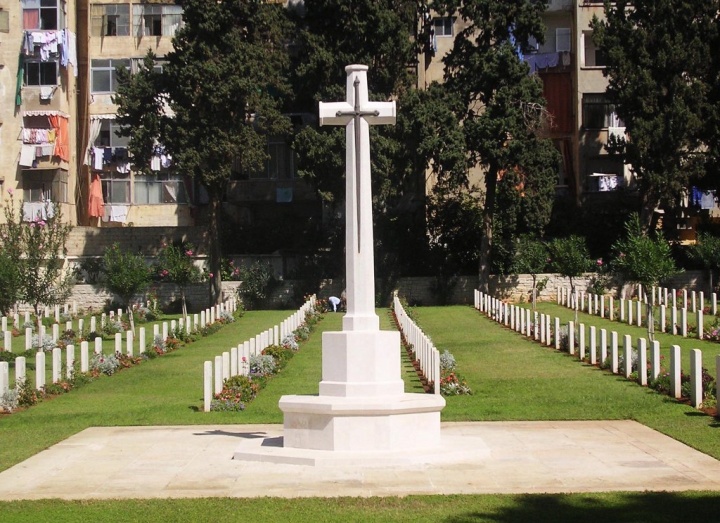
BEIRUT WAR CEMETERY:
Lebanon was taken from the Turks in 1918 by Commonwealth forces with
small French and Arab detachments. Beirut was occupied by the
7th (Meerut) Division on 8 October 1918 when French warships were
already in the harbour, and the 32nd and 15th Combined Clearing
Hospitals were sent to the town. The cemetery is in two
sections. One section, originally known as Beirut British War
Cemetery, was begun in October 1918 and was later enlarged when
graves were brought in from other burial grounds in the area.
The older part of the adjoining section, originally known as Beirut
(Saida Road) Indian and Egyptian Cemetery, contains three memorials
to soldiers of the Indian army and the Egyptian Labour Corps who
died during the First World War. This section was later
extended for Second World War burials, and the two sections combined
under the name of Beirut War Cemetery.
――――♦――――
STANLEY COLLIER
Able Seaman, Royal Navy, service number 234001(PO).
Son of George and Annie Collier.
Drowned, aged 28, when HMS Hampshire was sunk off the Orkneys, 5th
June 1916.
Buried in Lyness Royal Naval Cemetery, Orkney, grave ref. F.33A.
Stanley Collier was born in Hastoe on the 6th May, 1888 (Census
records state 1889). He signed up in the Royal Navy at
Portsmouth on the 6th May, 1906, for a period of 12 years.
According to Royal Navy records his occupation then was “Woodsman’s
Asst.”; his height 5ft 6in; light brown hair and blue eyes;
sallow complexion. At the time of his death Royal Naval
records give his next of kin as his mother, Ann, then living at 68
Brook Street, Tring.
The cruiser Hampshire was mined and sunk north of Scapa Flow in the
Orkney Islands on the 5th June 1916. On board was Lord
Kitchener (Secretary of State for War and a Cabinet Minister)
together with a delegation who were travelling to Murmansk in
Northern Russia there to meet the Russian Imperial Command.
Kitchener’s body was never found, but the body of Able Seaman
Stanley Collier, one of the crew, was recovered from the sea and
buried in the military cemetery on the Island of Hoy.
From the Bucks Herald, 24th June 1916:
“TRING MAN
ON THE HAMPSHIRE.−Amongst those who
went down with the Hampshire when it was mined and sank off the
Orkneys was Stanley Collier, who had been in the Navy about 11
years, and who had seen some stirring adventures in different parts
of the world.”
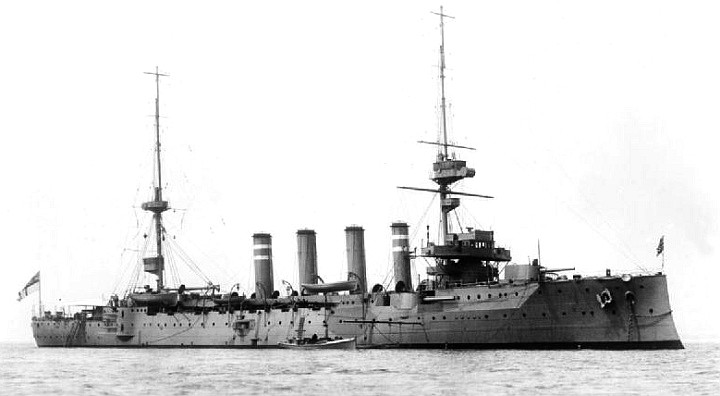
H.M.S. Hampshire
From the Tring Parish Magazine:
“One of our Tring lads, Stanley Collier,
was on HMS. Hampshire when she was mined off the Orkney’s and sank
with Lord Kitchener aboard, on 5th June 1916.
Collier joined the Navy in June 1905 and before the war had sailed
to the farthest parts of the empire. He was on the ship which
rescued the Duke and Duchess of Fife, when they were nearly drowned
off the North Coast of Africa. Earlier in the war, he was for
sometime on a minesweeper which was sunk off Lowestoft. He was
picked up, after spending some time in the water. He was in
the recent Battle of Jutland. Two days after his parents heard
the news of his death they received the following letter dated 4th
June.
‘Just a few lines to let you know that I am quite well, I hope you
are all well at home and that you have not been worrying about me at
all. Our ship took part in the naval battle the other day, we
sank one cruiser, but our ship did not receive any damage all, and
no casualties. Do not worry about things you read in the
papers, a great deal of which is not true’. His parents have
since received information that his body has been recovered and
buried on the Island of Hoy, Orkney Islands on 8th June 1916.
He was a sailor of the best type, keen on his work, anxious to be in
the thick of the fight and yet, deeply attached to his home.
When in Port, on one of his voyages, he was confirmed by Bishop
Collins, of Gibraltar. He died, we believe, a loyal servant of
Jesus Christ. R.I.P.”
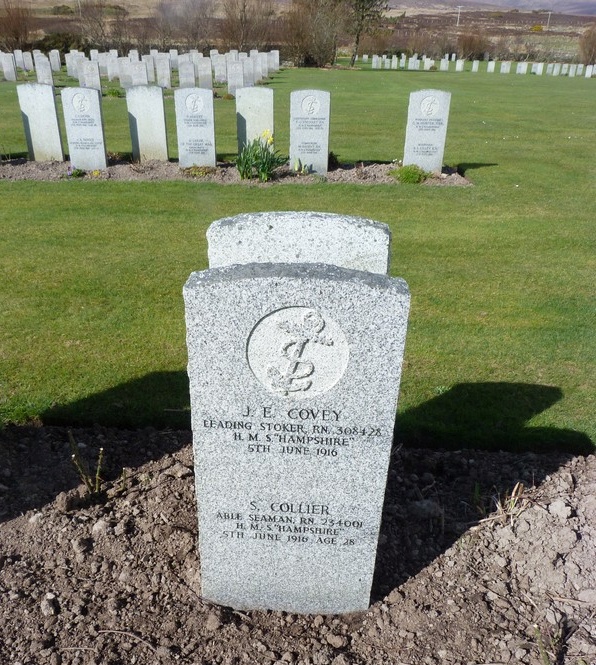
Lyness Royal Naval Cemetery is on the Island of Hoy in Orkney,
between Mill Bay and Ore Bay. The Cemetery was begun in 1915
when Scapa Flow was the base of the Grand Fleet and remained as a
Royal Naval base until July 1946. It contains 445 Commonwealth
burials from the First World War, including officers and ratings
lost from H.M.S. Hampshire.
――――♦――――
JESSE COLLINS
Private, 11th Royal West Kent Regiment (transferred to 99th Training
Reserve) service no. G/9805.
Son on Charles and Polly. Husband of Elizabeth Smith (formerly
Collins) of Lysons Road, Aldershot.
Died of pneumonia on 25th December 1916, aged 50.
Buried in Aldershot Military Cemetery, grave ref. AF 2038.
Jesse Collins was born in Pitstone in 1869. In the 1891 Census
he is recorded lodging in Akeman Street, Tring, his occupation being
farm labourer. He
married Elizabeth Barber at Tring Parish Church on the 9th October
1897. In the 1911 Census Jesse is recorded living with his
wife and two children (Jessie Elizabeth aged 8, and Harry Charles
aged 3) at 4 Clement Place, Tring, his occupation being general
labourer. Private Collins enlisted at Watford.
From the Parish Magazine, February 1917:
“Jesse Collins, who joined the Royal West
Kent Regiment in August 1915, died form a sharp attack of pneumonia
at the Connaught Hospital, Aldershot on 25 December 1916. He
was buried at Aldershot, with full military honours.”
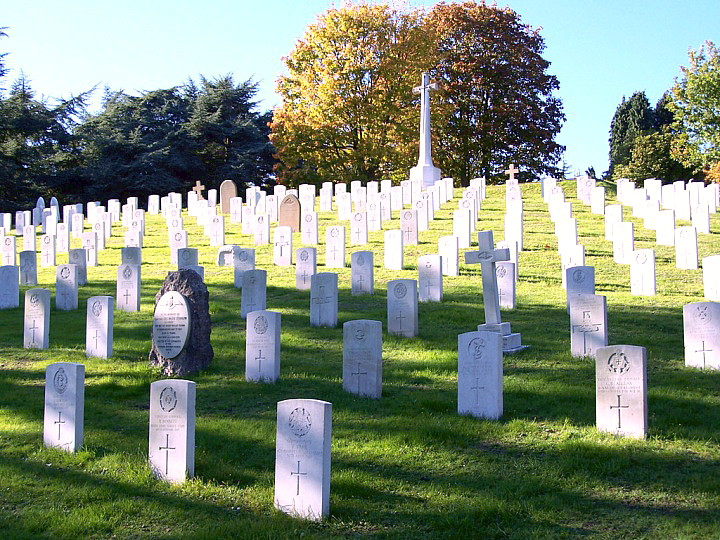
Aldershot Military Cemetery is the property of the Ministry of
Defence. At the outbreak of The First World War, Aldershot was
the headquarters of the Aldershot Command and of the 1st and 2nd
Divisions, and the Depot of the Royal Army Medical Corps. The
North and South Camps, divided by the Basingstoke Canal, remained in
full activity throughout the War. There are 692 First World
War graves in the cemetery, the earliest bears the date 5th August
1914, and the latest 11th August 1921.
――――♦――――
CHARLES JESSE CRAWLEY
Private, 2nd Middlesex Regiment, service no. L/11905.
Killed in action on the 2nd June 1915, aged 26.
Born in Aldbury, son of Sabrina and the late Joseph Crawley.
No known grave. Commemorated on the Ploegsteert Memorial, Belgium, Panel 8.
Charles Jesse Crawley was the son of George Crawley, one of the two
Aldbury men murdered by poachers in the Stocks woodland in 1891.
Extracts from a letter from the Archivist of
King Edward’s School, Witley,
Godalming:
“Thank you for your letter regarding
Charles Jesse Crawley and your request for information about his
time at King Edward’s School, Witley. As you might be aware
when Charles was admitted to Bridewell Royal Hospital, King Edward’s
School, Witley in 1900 the school was very different from the school
today. All boys were fatherless or orphans and either their
school or church would have made a Petition to Bridewell Royal
Hospital for them to enter King Edward’s as a deserving case.
The boys were given a good Christian education, an ‘occupation’ to
teach them skills to fit them for life and plenty of drill and
exercise. The boys wore a naval uniform and slept in hammocks.
Charles and Harold were both eligible to come to School given the
tragic circumstances of their father’s death and the early death of
their mother . . . .
Charles was born in 1888, one of 7 children. Their father, a
gamekeeper, was killed in 1891 by poachers and so when old enough he
and his brother Harold were sent to KES. He came in 1900 from
his home in Aldbury. He was described as a very good tailor.
Sadly his mother died in 1901 and when he left in 1903 he went to
work in the household of the President, Sir George Faudel-Phillips.
He did not stay there long and returned to Aldbury to be a butcher.
In 1907 he joined the Middlesex Regiment.
Charles was killed in action and has no known grave. In 1907
when he joined up he was described as ‘honest, clean, intelligent
and trustworthy’. He was part of the British Expeditionary
Force and saw action almost immediately. He was killed during
day to day trench warfare in the Ypres area. His younger
brother was killed in 1916, both men were 26 years old when they
died.”
From the Bucks Herald, 3rd July 1915:
“We have another name to add to our
lengthening Roll of Honour − Charles Crawley, Private in 1st
Middlesex Regiment, who at the beginning of the war, was called up
to rejoin the Colours, and has, from the first, been with our
expeditionary Force in France. In the Spring he was slightly
wounded, but made a good recovery, alas! very shortly afterwards to
meet his death. The following letter tells us how he died:
3rd June 1915.
It is with many regrets that I have to inform you that my dearest
friend, your brother, Charles Crawley, was killed in action at 5.10
p.m. yesterday, the 2nd June. The enemy was bombarding the
trenches, and a highly explosive shell burst through the roof of the
dug-out he was in, burying him in the debris. When the rescue
party were able to get him out , I am given to understand that he
merely murmured ‘Oh, mother, Oh! mother,’ expiring immediately.
He was not wounded; so apparently it was shock shock which caused
his death. I feel the loss acutely; he was my great chum
during our sojourn in India. He was known and respected by
many, being a great favourite.”
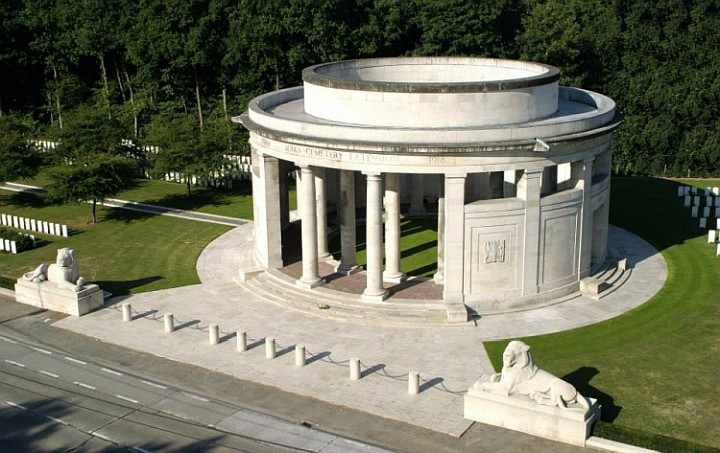
The PLOEGSTEERT MEMORIAL commemorates more than 11,000 servicemen of
the United Kingdom and South African forces who died in this sector
during the First World War and have no known grave. The
memorial serves the area from the line Caestre-Dranoutre-Warneton to
the north, to Haverskerque-Estaires-Fournes to the south, including
the towns of Hazebrouck, Merville, Bailleul and Armentieres, the
Forest of Nieppe, and Ploegsteert Wood. Most of those
commemorated by the memorial did not die in major offensives, such
as those which took place around Ypres to the north, or Loos to the
south. Most were killed in the course of the day-to-day trench
warfare which characterised this part of the line, or in small scale
set engagements, usually carried out in support of the major attacks
taking place elsewhere.
The cemetery, cemetery extension and memorial were designed by
Harold Chalton Bradshaw, with sculpture by Gilbert Ledward.
The memorial was unveiled by the Duke of Brabant on 7th June 1931.
――――♦――――
ULTIMUS GEORGE CRAWLEY M.M.
Private, 6th Oxfordshire and Bucks Light Infantry, service no. 9829.
Born in Wigginton, son of the late Mr. and Mrs. Samuel Crawley of
Cholesbury.
Killed in action on 20th September 1917, aged 24.
No known grave. Commemorated on Tyne Cot Memorial, Belgium, panels 96
to 98.
Little is known about Ultimus George Crawley. He lived at
Cherrytree Cottages, Cholesbury Common (on the extreme edge of the
Tring Parish), he enlisted as a Private in the Oxford and Bucks
Light Infantry and was killed in France 20th September 1917, having
been awarded the Military Medal for Bravery that August.
The 6th (Service) Battalion, Ox and Bucks Light Infantry was raised
at Oxford in September 1914 as part of Kitchener’s Second New Army.
During 1917 its battalions saw service in many of the subsidiary
actions that took place during the Third Battle of Ypres (i.e.
Passchendaele − 31st July–6th November). These included the
Battle of Menin Road, a general attack that took place in the Ypres
Salient between the 20th and 25th September. Judging from the
date of his death it is possible that Private Crawley was killed at
the start of that action.
By early September optimism had increased among German commanders
that the Flanders offensive had been defeated and they transferred
some of their forces elsewhere. Added to this, for the first
time that year the weather gave advantage to the British − the
continuous rain that had turned the battlefield into a quagmire let
up for ten days, and in the relatively dry ground General Plumer’s [Notes]
men dug trenches, repaired roads and prepared for battle.
At the Battle of Menin Road, Plumer tried a new approach to attack
referred to as “bite and hold.” [Note] It involved units achieving
small victories and then consolidating the ground they
had taken, rather than pressing on. This helped them blunt
German counter-attacks. |
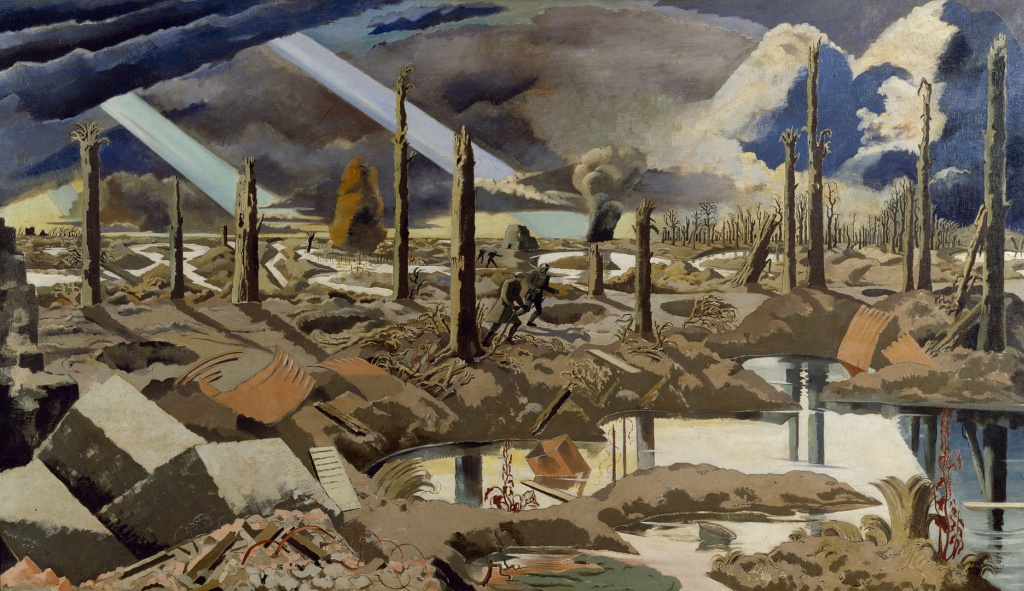
Menin Road, by Paul Nash - oil on canvas, 1918-19
Drier weather and extensive road repairs made it much easier for the
British to move vast amounts of supplies forward from the original
front line. Visibility increased except for frequent ground
fog around dawn, but this helped conceal British infantry during the
attack before clearing to expose German troop movements to British
observation and attack.
The Battle of Menin Road was not a battle of great spectacle,
neither was it flawlessly executed, but it proved the value of bite
and hold tactics. For not only did the British, Australian,
and New Zealand troops make important advances, but by consolidating
their gains they retained the ground taken against German
counter-attacks.
The following is the the Battalion Commander’s (Lieut.-Colonel C. R.
C. Boyle) account of the attack on the 20th September 1917, the day
on which Private Crawley was killed.
“THE 6th OX & BUCKS ATTACK OF THE 20TH
SEPTEMBER, 1917.
At midnight 18th/19th September the Battalion was disposed as
follows:—
B Company: (2nd Lieut. Mitchell) holding front line U.23.d.7.4 to
U.23.d.4.5, with two platoons. H.Q. and three platoons round Double
Cotts (U.23.d.3.8).
C Company (Captain Brooks) in trenches round Au Bon Gite.
(U.28.d.7.8).
A Company (Captain Skuce) in trenches round Adelphi (C.3.a.8.9).
D Company (Lieut. Cooke) in trenches near Cork House (C.3.a.3.3).
Battalion H.Q. at Au Bon Gite.
The 19th September was quiet, except for a little hostile
shelling. That evening, as soon as it was dark, and companies
had got their rations, they moved forward into assembly positions,
which had all been taken up by 2 a.m. (20th). A Company lost
10 men in moving up, otherwise there were no casualties in the
Battalion. The disposition of companies was now: A left, C centre, B
right, D reserve.
Each of the three front companies formed up in four lines, one
platoon in each of the first three lines, and Company H.Q. with one
Lewis gun in the fourth line. Each company had a covering
party 150 yards to the front. D Company (in reserve) was
formed in columns of half platoons and in two lines; two platoons in
the frontline, and one platoon and Company H.Q. in rear.
Battalion H.Q. were at Double Cotts (Twin Cottages).
At 5 a.m. (20th September) 2nd Lieut. Willes (Intelligence
Officer) and 8 Scouts took up positions with D Company. 8
Scouts being sent to each of the three attacking, companies.
Touch was obtained with the 12th R.B. [Rifle Brigade]
on the right, but no touch could be got with the 59th Brigade on the
left, and there was a gap of at least 150 yards between.
2nd Lieut. Willes laid out tapes on pegs already provided by the R.E.
[Royal Engineers], and led
companies to assembly positions. Zero was 5.40 a.m. 20th
September. It was then still dark, dawn just breaking.
At 5.41 a.m. oil drums were discharged at Cemetery (U.14.C.0.0).
These lit up the sky and showed my men to the enemy. As soon
as the leading lines came over the ridge, into view of Eagle Trench,
they came under heavy machine-gun fire from five concrete houses in
the trench. B Company, on the right, caught the worst of this,
and soon lost all their officers and most of their N.C.O.’s. C
Company, in the centre, gallantly led by Captain Brooks and 2nd
Lieut. Bevington, tried to get on, and were within 60 yards of the
trench, when they were finally held up, Captain Brooks being killed
on the German wire. 2nd Lieut. Bevington and three or four men
succeeded in getting into the trench, but were wounded and could do
no more.
A Company got within 70 yards, and were then held up; Captain Skuce
was mortally wounded. D Company tried to get forward to
reinforce and push on, but were unable to do this, and at 6.30 a.m.
all companies were in shell-holes west of Eagle Trench, digging in.
It was impossible to get orderlies back to H.Q., and it was not
until 7 a.m. that I learned the situation.
The 59th Brigade, on the left, were held up on the same line, and
the 12th R.B. on my immediate right. The situation remained
thus during the day, all movement being under the observation of the
enemy, who had snipers, on the look-out.
A fresh attack was ordered for 5.30 p.m., the 6th K.S.L.I,
[King’s Shropshire Light Infantry]
to send one company to help to get on, and another to work round the
right with the 12th R.B. I was able to send orders to D Company
(Lieut. Cook), but I could not communicate with any other officer.
At 5 p.m. the enemy put down a heavy barrage on the line
U.23.d.l.4-U.29.b.2.9, but did not attack opposite me.
At 6.30 p.m. our barrage came down on Eagle Trench, and
Lieut. Cook collected all men near him, and, with 2nd Lieut. Tapper,
went forward. The enemy surrendered to him, and Lieut. Cook
took a party and bombed along Eagle Trench, meeting with little
opposition until about U.23.b.3.0.5, where his bombs gave out, and
the enemy bombed him back. He then sent forward some riflemen
to the right flank to hold the enemy, whilst he collected all German
stick-bombs and formed a block in the trench, which he held.
2nd Lieut. Tapper, seeing that this attack was succeeding, pushed
forward to Louis Farm, taking with him about 20 men of B Company,
under Sergeant Walker. Here they linked up with the 6th
K.S.L.I. and the 12th R.B.
A line of posts was then dug from Eagle Trench east, along the edge
of the Cemetery, and south of the road to Louis Farm, with another
line running east of the Cemetery back to Eagle Trench. I
ordered 2nd Lieut. Tapper to withdraw from Louis Farm, and, with
Lieut. Cook, to hold the Cemetery with D Company, B Company
remaining at Louis Farm. A Company (2nd Lieut. Scogings) held
the block in Eagle Trench. C Company was still west of the
trench. This was the situation at midnight 20th/21st
September.
The 21st September was comparatively quiet, except for a
S.O.S. in the evening, but the enemy did not attack opposite my
front. That evening the Battalion was relieved by the 12th
K.R.R.C., [King’s Royal Rifle Corps]
and withdrew east of the Steenbeek. Besides myself there were
only four officers left. A and B Companies, under 2nd Lieut.
Scoging, went to shelters in the trench about U.5.b.8.8, while C and
D, under Lieut. Cook, went to trenches by Cork House. H.Q. in Candle
Avenue.
September 22nd. — C and D Companies were heavily shelled,
Lieut. Cook and 2nd Lieut. Tapper being wounded. In the
evening we were relieved by the 7th K.O.Y.L.I., [King’s
Own Yorkshire Light Infantry] and companies
went back to Wolfe Camp (Malakoff Farm area).
The casualties were 3 officers killed and 9 wounded. Other ranks,
40 killed, 123 wounded, and 33 unaccounted for — probably killed.”
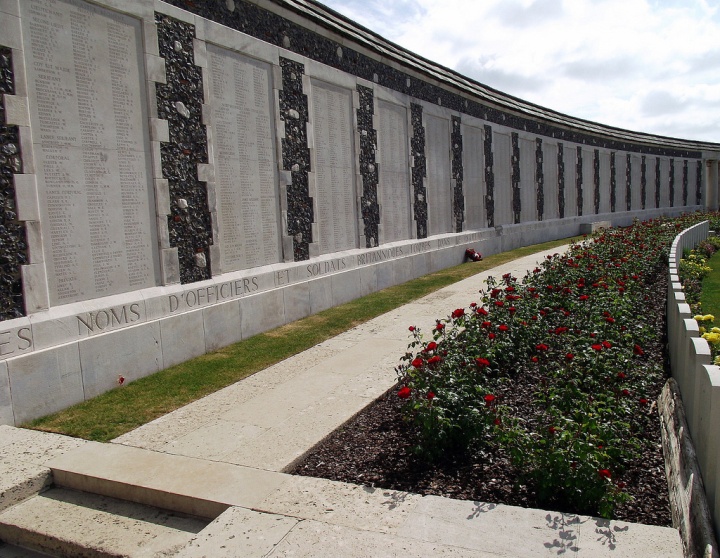
The Tyne Cot Memorial is one of four memorials to the missing in
Belgian Flanders which cover the area known as the Ypres Salient. It
bears the names of almost 35,000 officers and men whose graves are
not known. The memorial was designed by Sir Herbert Baker, with
sculpture by Joseph Armitage and F.V. Blundstone.
――――♦――――
GEORGE CROCKETT
Private, 2nd Bedfordshire Regiment, service no. 20466.
Killed in action on the 30th July 1916 aged 19.
Born in Tring. Son of Jesse of 22 Pleasant Row, Akeman Street.
Buried in Terlincthun British Cemetery, France, grave ref. X. AA. 13 (Jt.).
Born in Tring, the 1911 Census records George Crockett, then aged
14, living at 2 Tabernacle Yard (off Akeman Street) with his
parents, Jesse and Dora, and his sister Loura (aged 11). His
employment is given as farm labourer.
Private Crockett enlisted in the 2nd Bn. the Bedfordshire Regiment,
at Bedford, in April 1915. From the Bucks Herald,
16th September 1916:
“THE WAR.−
Missing Private George Crockett (2nd Bedfordshires); son of Mr Jesse
Crockett; who was previously wounded, is reported as missing since
July 30th.”
From the Bucks Herald, 30th June 1917:
“A MISSING SOLDIER.
− We regret to learn that George Crockett of Tabernacle Yard, Akeman
Street who has been missing nearly 12 months, has now been reported
killed in the Battle of the Somme. He belonged to the Bedford
Regiment which he joined in the Spring of 1915 on attaining the age
of 18 years, going to France some 12 months later.”
From the Parish Magazine:
“George Crockett was originally reported as
missing on 30th July 1916 during the battles on the Somme. It
has now been confirmed that he was in fact killed in action on that
day. He joined the 2nd Bedfords in April of 1915 at the age of
eighteen years. After a year spent in training at Felixstowe
he went to France in the Spring of 1916. His last letter home
was dated 22nd July 1916. His platoon officer wrote that he
had been slightly wounded around that date. Since then he had
been entirely lost sight of. It must be that his body was
eventually recovered and buried at a later date.
He is buried in the Terlincthun British Cemetery, Wimille. His
grave is a double grave, together with an unknown British soldier.”
The date of Private Crockett’s death and his unit’s
recorded location suggests that he was killed in an early attack on
Guillemont during the Battle of the Somme. This village is
situated about 6½ miles east of Albert on the junction of the D64
and D20 roads. The Germans positioned there defied British
attacks on the 30th of July (the date of Private Crockett’s death)
and the 8th of August. These bloody encounters led to partial
and temporary occupations of the shattered ruins of the village as
determined German counter-attacks and continuous artillery fire
forced British withdrawals. The village was finally taken on
the 3rd September, 1916.
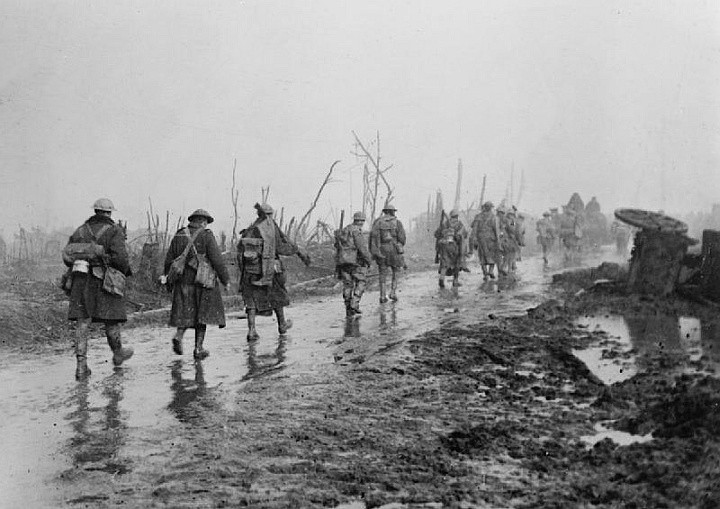
Soldiers coming out of the trenches at
Guillemont.
These extracts are from the War Diary [Note] of the 2nd Bn. Bedfordshire
Regiment:
“DAY THIRTY OF THE
SOMME: Today the attack on Guillemont,
anticipated since 16th of this month, has got underway. This
attack has been undertaken by 30th Division, including 2nd
Battalion, Bedfordshire Regiment. Having spoken with the
Battalion’s adjutant it seems they were in reserve for the attack
which was spear-headed by 19th and 20th Battalions, King’s
(Liverpool) Regiment with 17th Liverpools in support. The
attack was made in conjunction with an attack by the French, 30th
Division being the most right-hand units of the British
Expeditionary Force in France. A Company of the Bedfords,
however, was part of the assaulting troops . . . . About 1.30 this
afternoon it became clear that the attack on Guillemont had stalled
and the Bedfords were ordered to consolidate a line along the low
ridge from a small wood called Arrowhead Copse, just short of
Guillemont, east to the French left wing. This they did,
digging a new trench about 300 yards long. It is anticipated
that the battalion will be relieved tonight, having suffered 6
officers and 186 other ranks dead and wounded . . . . To assist the
attack on Guillemont subsidiary attacks were made to the north-west
at Longueval and Delville Wood again. This attack was confused
and extremely costly and seems to have gained little or nothing.
The fighting in this area may be described, not melodramatically, as
a blood-bath and one of the Battalions of 5th Division is reported
to have been reduced from 1,000 at full strength to just 175.”
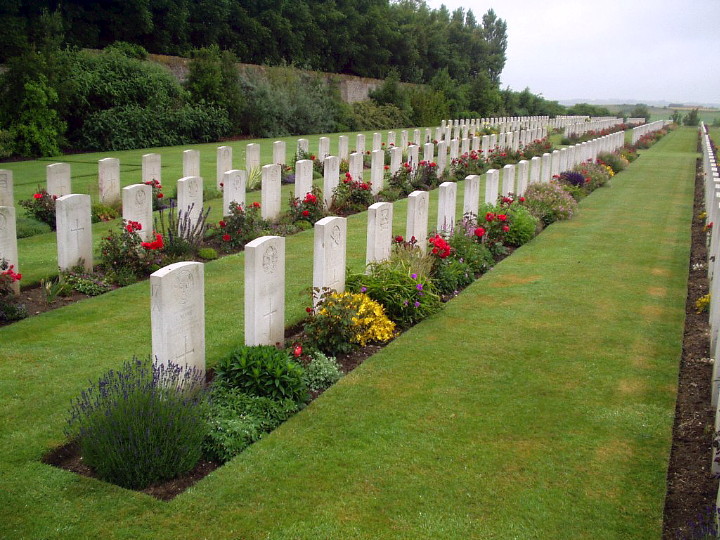
Terlincthun British Cemetery is situated on the northern outskirts
of Boulogne. The cemetery at Terlincthun was begun in June
1918 when the space available for service burials in the civil
cemeteries of Boulogne and Wimereux was exhausted. It was used
chiefly for burials from the base hospitals. In July 1920, the
cemetery contained more than 3,300 burials, but for many years
Terlincthun remained an ‘open’ cemetery and graves continued to be
brought into it from isolated sites and other burials grounds
throughout France.
Private Crockett is buried in a joint grave, which he shares with an
unknown soldier.
――――♦――――
ARTHUR ALBERT CROSS
Private, Royal Bucks Hussars, Household Cavalry.
Enlisted at Aylesbury. Service
no. 205990.
Born in Tring. Son of Mrs. Crawley of Waverley, Longfield-road,
Tring.
Killed in action in Palestine on 28th November 1917 aged 22.
Buried in Jerusalem War Cemetery, Israel, grave ref. A.18.
At the outbreak of the First World War, Palestine (now Israel) was
part of the Turkish Empire and it was not entered by Allied forces
until December 1916. The advance to Jerusalem took a further
year, but from 1914 to December 1917, about 250 Commonwealth
prisoners of war were buried in the German and Anglo-German
cemeteries of the city. [Note]
By 21st November 1917, the Egyptian Expeditionary Force had gained a
line about five kilometres west of Jerusalem, but the city was
deliberately spared bombardment and direct attack. Very severe
fighting followed, lasting until the evening of 8th December, when
the 53rd (Welsh) Division on the south, and the 60th (London) and
74th (Yeomanry) Divisions on the west, had captured all the city’s
prepared defences. Turkish forces left Jerusalem throughout
that night and in the morning of 9th December, the Mayor came to the
Allied lines with the Turkish Governor’s letter of surrender.
Jerusalem was occupied that day and on 11th December, General
Allenby [Note] formally entered the city, followed by representatives of
France and Italy.
Meanwhile, the 60th Division pushed across the road to Nablus, and
the 53rd across the eastern road. From 26th to 30th December,
severe fighting took place to the north and east of the city but it
remained in Allied hands.
From the Bucks Herald 15th December 1917:
“THE ROLL
OF HONOUR.− News has just been received
by Mrs. Crawley of Waverley, Longfield-road, of the death of her
son, Albert Arthur Cross, who was killed in action in Palestine on
November 28. Enlisting in the Royal Bucks Hussars in July,
1915, Pte. Cross, after training, was eventually drafted to Egypt in
March, 1916. He has taken part in the operations in which the
regiment has participated. The deepest sympathy is felt for
the bereaved parent, this being the second son killed in the war,
whilst a son-in-law was one of the victims of the sinking of the
Aboukir in 1914. Previous to the war Pte. Cross, who was 24
[22] years of age, was a steward
on the SS Highland Lock, but gave up his position to join the
Forces. As a lad he was employed by Miss Williams, Hawkwell,
by whom he was held in the highest esteem. He was a keen
member of the Tring Company, C.L.B. [Church Lads’
Brigade], and for many years a chorister in
the Parish Church.”
From the Parish Magazine May 1918:
“Albert Arthur Cross met his death on Nov
28th when fighting with our forces advancing on Jerusalem. At
the outbreak of war he was serving as a steward aboard the S.S.
Highland Loch. He heard the country’s call, joining the Royal
Bucks Hussars, and in March of 1916, was sent to Egypt. He was
very soon attached to the Palestine Expeditionary Force and keenly
looked forward to reaching the holy places. He was brought up
in our schools, sang in the parish choir, was a promising member of
the Church Lads’ Brigade in its most flourishing days. He
leaves behind him a happy memory. May he rest in peace.”
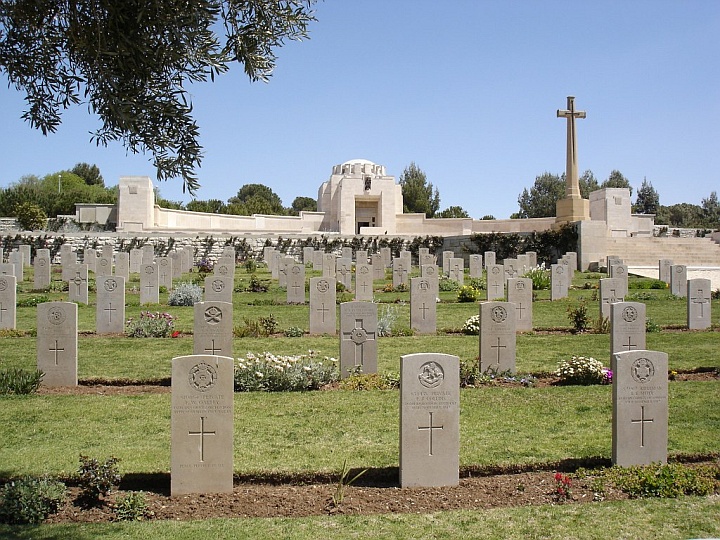
JERUSALEM WAR CEMETERY
was begun after the occupation of the city, with 270 burials.
It was later enlarged to take graves from the battlefields and
smaller cemeteries in the neighbourhood. There are now 2,515
Commonwealth burials of the First World War in the cemetery, 100 of
them unidentified. Within the cemetery stands the JERUSALEM
MEMORIAL, commemorating 3,300
Commonwealth servicemen who died during the First World War in
operations in Egypt or Palestine and who have no known grave.
――――♦――――
HERBERT WILLIAM CROSS
Private, 1st Bn. Bedfordshire Regiment. Enlisted at Hatfield.
Service no. 4/4966.
Born in Tring. Son of Mrs. A. Crawley of 28 King Street,
Tring.
Killed in action on 7th September 1915.
Buried in Albert Communal Cemetery Extension, France, grave ref. 1. A. 9.
In early 1915, the 1st Battalion Bedfordshire Regiment was engaged
at the Second Battle of Ypres, defending Hill 60, but at the time of
Private Cross’s death the battalion does not appear to have been
engaged in any significant action to which his death might be
attributed.
Albert, where Private Cross is buried, is a town in France to the
north-east of Amiens. It was held by French forces against the
German advance on the Somme in September 1914, before passing into
British hands in the summer of 1915. The first fighting in the
locality in the following July is known as the Battle of Albert
(1916). The town was captured by the Germans on the 26th April
1918, and before its recapture by the 8th East Surreys on the
following 22nd August − in the Battle of Albert (1918) − it had been
completely destroyed by artillery fire.
From the Bucks Herald, 9th October 1915:
“OUR ROLL
OF HONOUR.− Another name has to be
added to our list. Somewhere in the trenches in France,
Herbert William Cross, 1st Bedfordshire Regiment, was instantly
killed by the explosion of a big shell. It is said to have
been impossible to recover his body, as it was literally buried
‘under tons of earth.’ He has given his life for his country:
may God accept his sacrifice.”
There is nothing in the Battalion War Diary to indicate
fighting in the locality in period in which Private Cross was
killed, so one must assume that he fell victim to the shelling of an
unknown target. His body must later have been recovered to
permit a burial to take place.
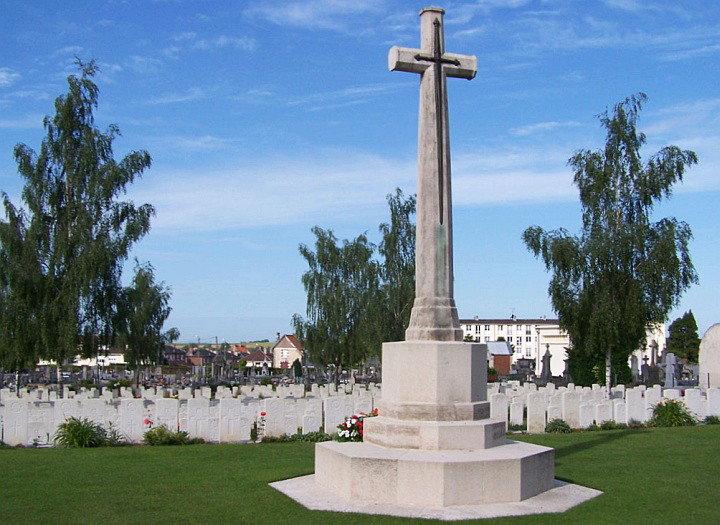
The Albert Communal Cemetery Extension was used by fighting units and Field
Ambulances from August 1915 to November 1916, and more particularly
in and after September 1916, when Field Ambulances were concentrated
at Albert. From November 1916, the 5th Casualty Clearing
Station used it for two months. From March 1917, it was not
used (except for four burials in March, 1918) until the end of
August 1918, when Plot II was made by the 18th Division.
There
are now 862 First World War casualties commemorated in this site, of
which 12 are unidentified.
――――♦――――
CUTLER to HAYSTAFF |
|